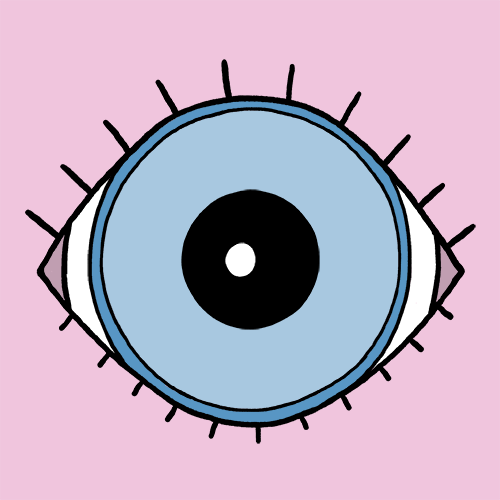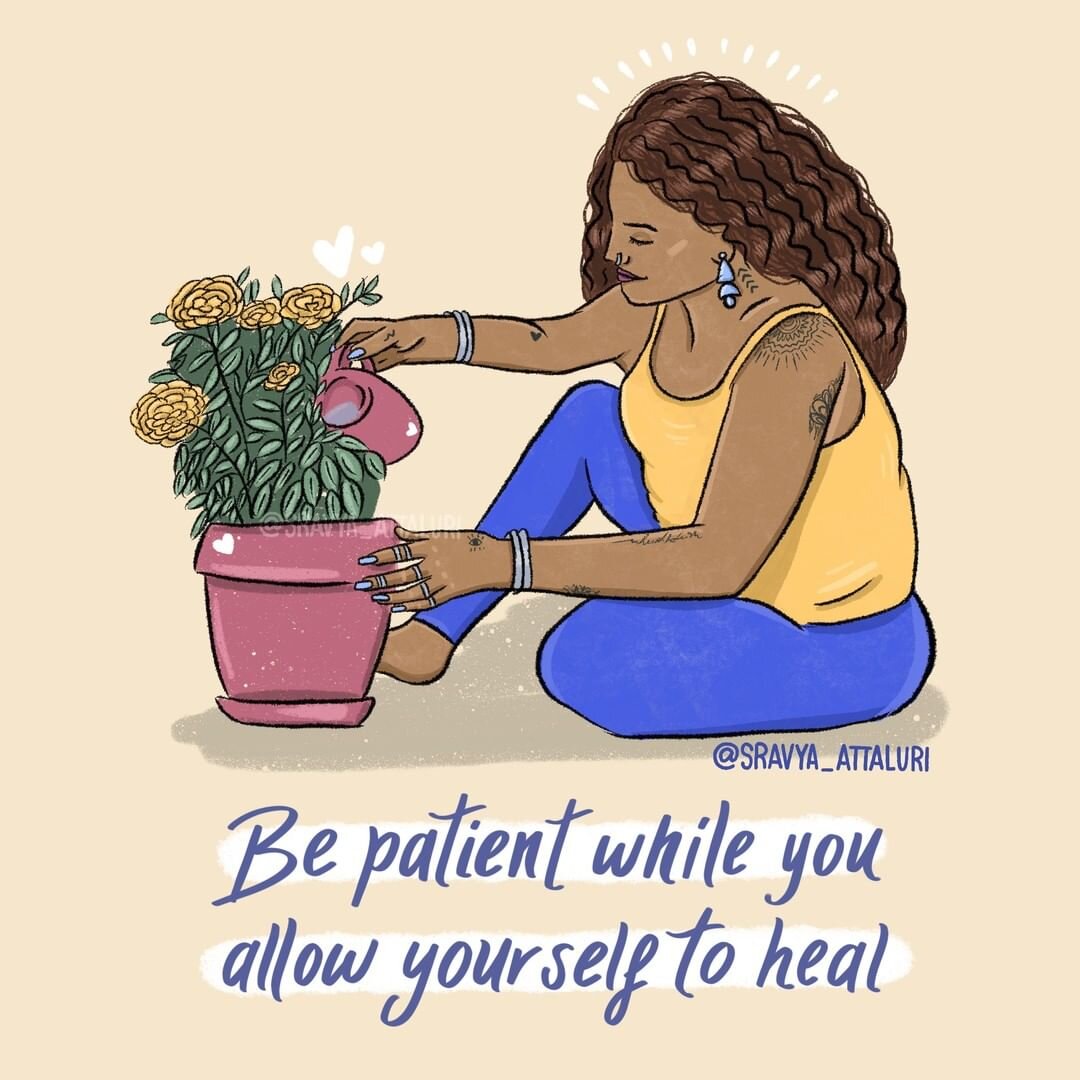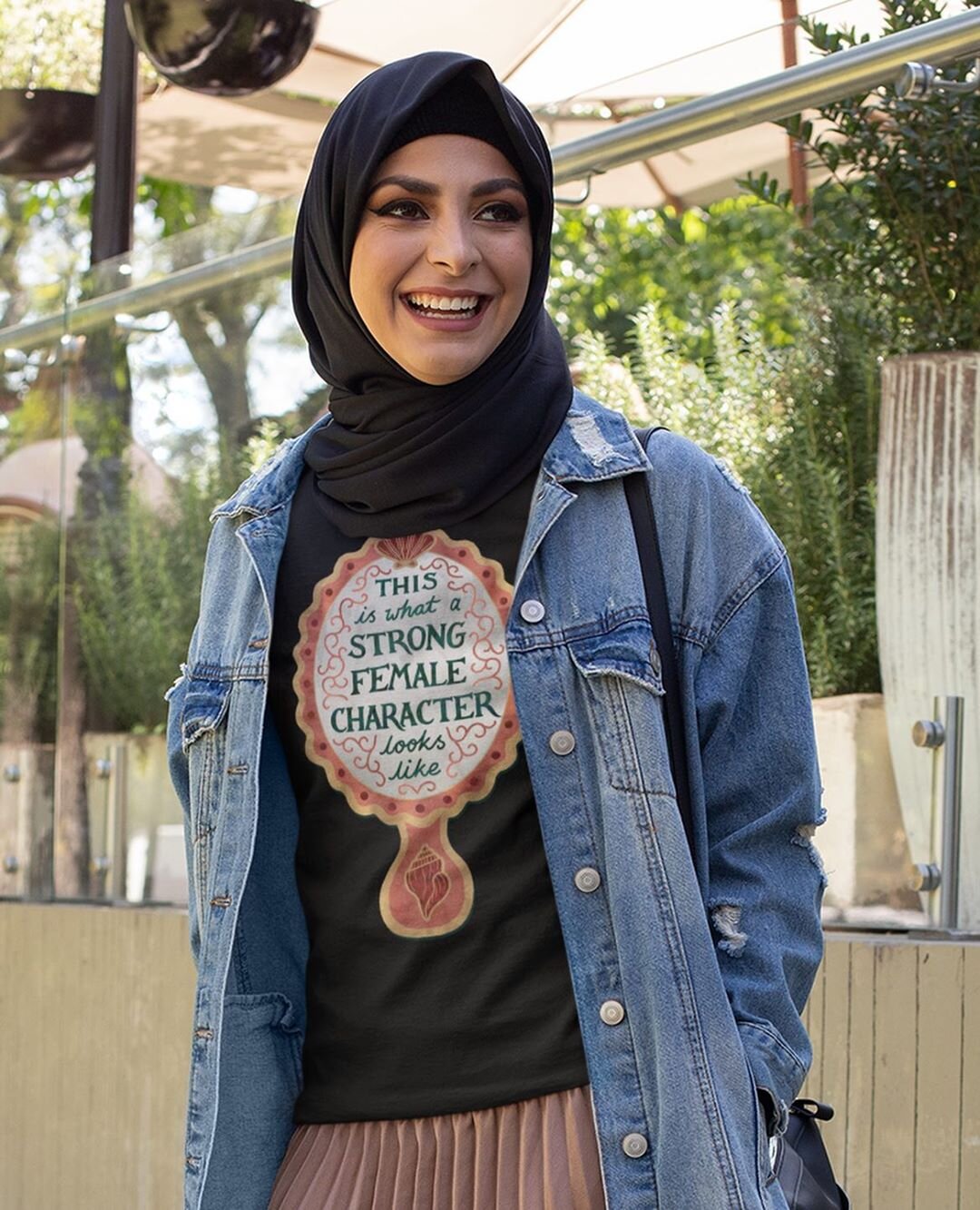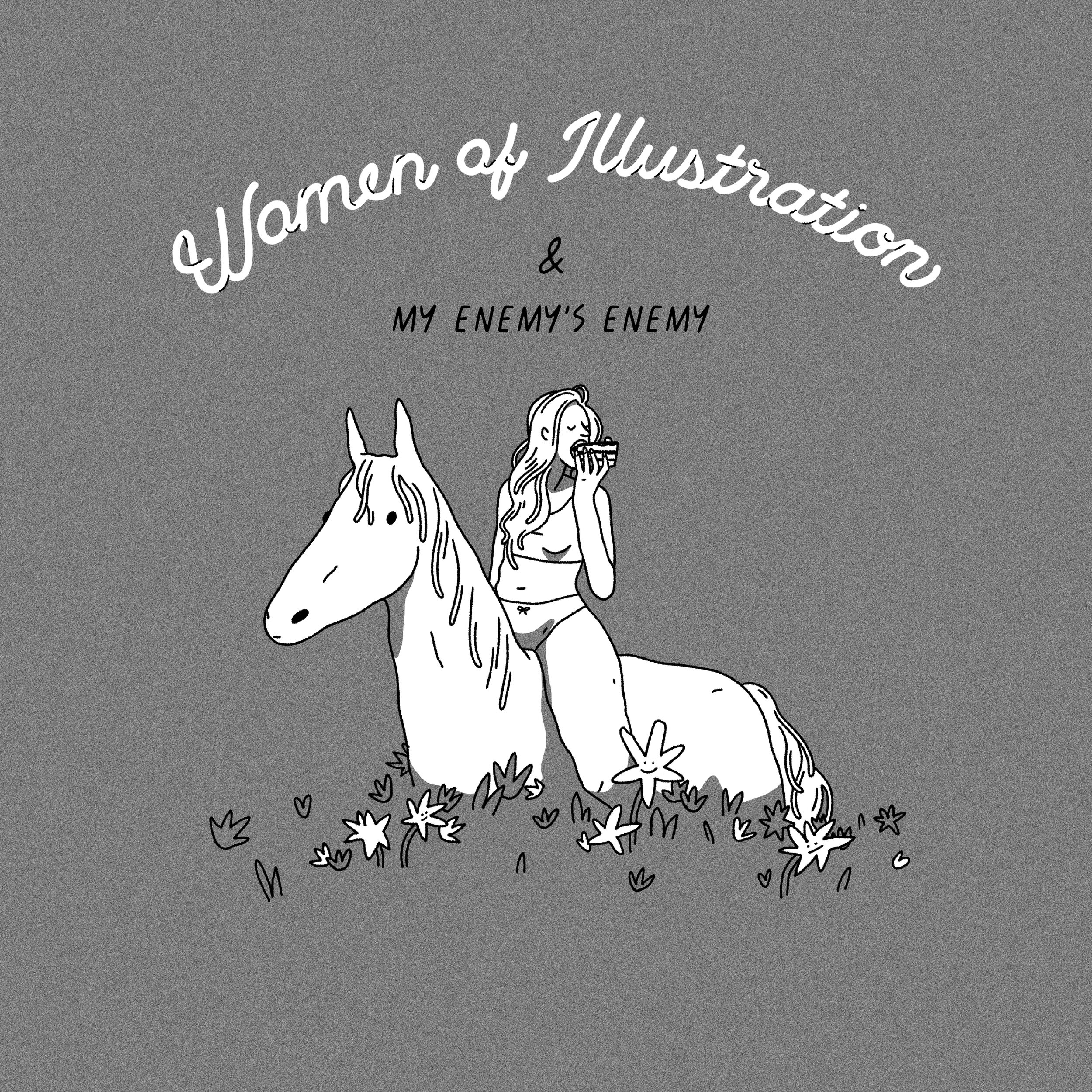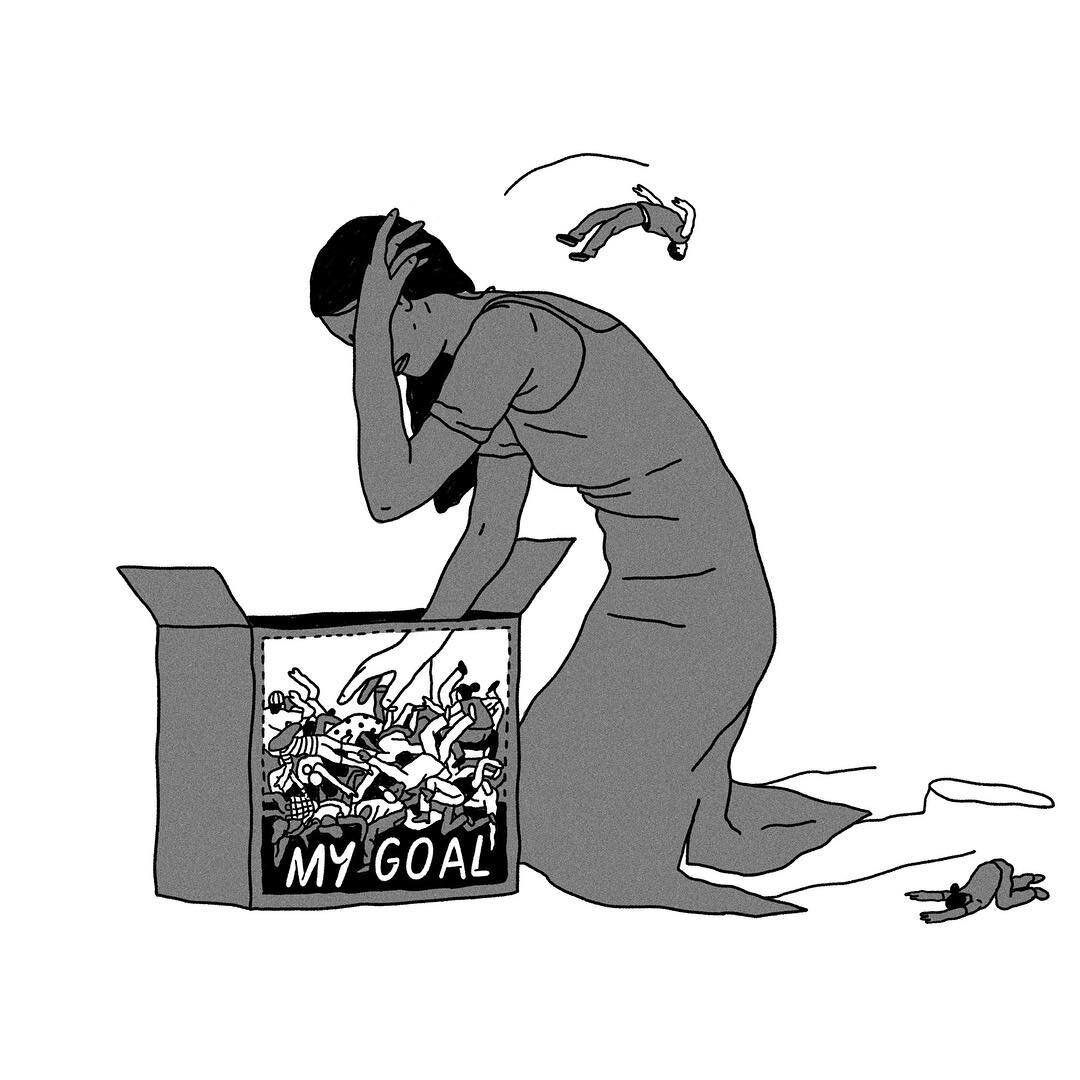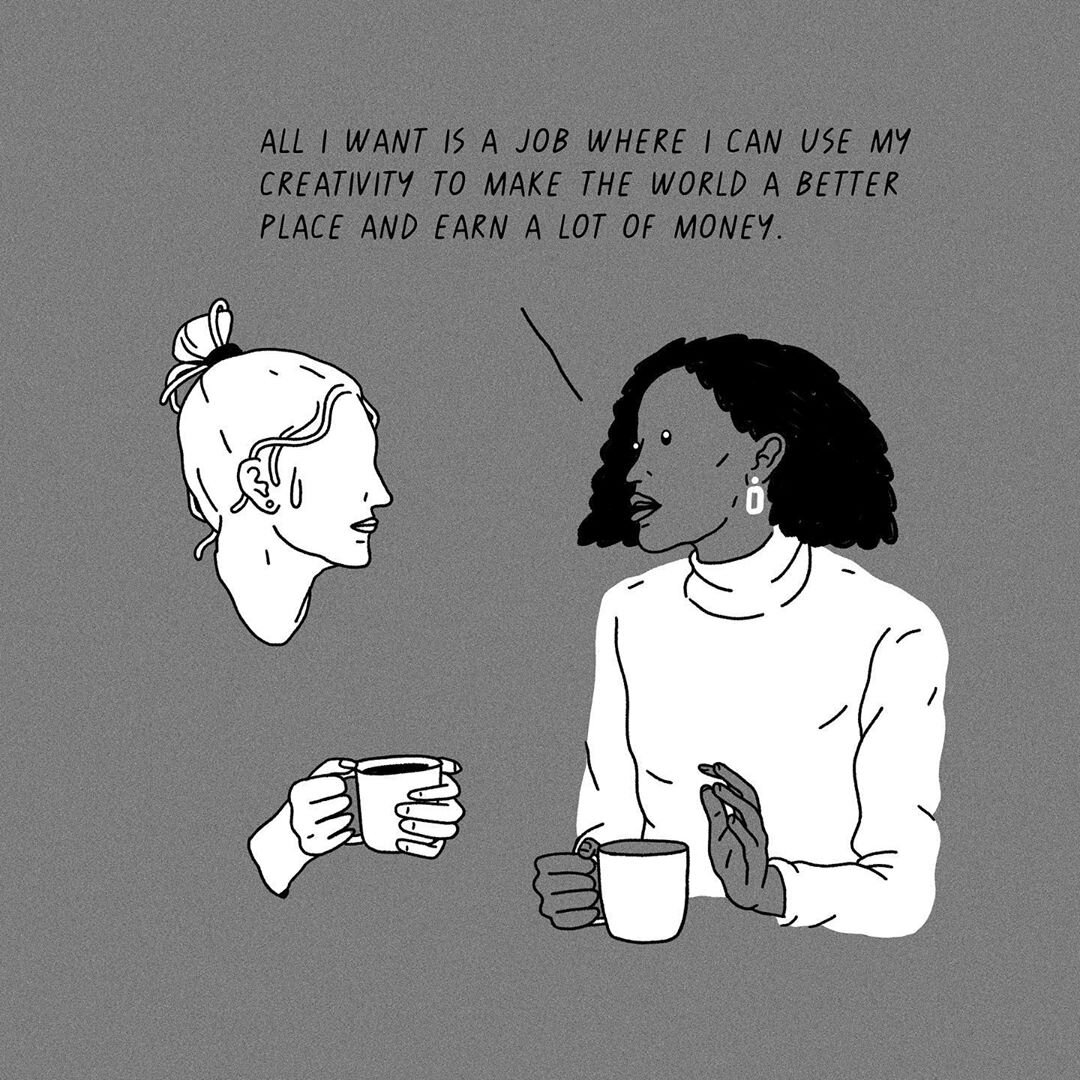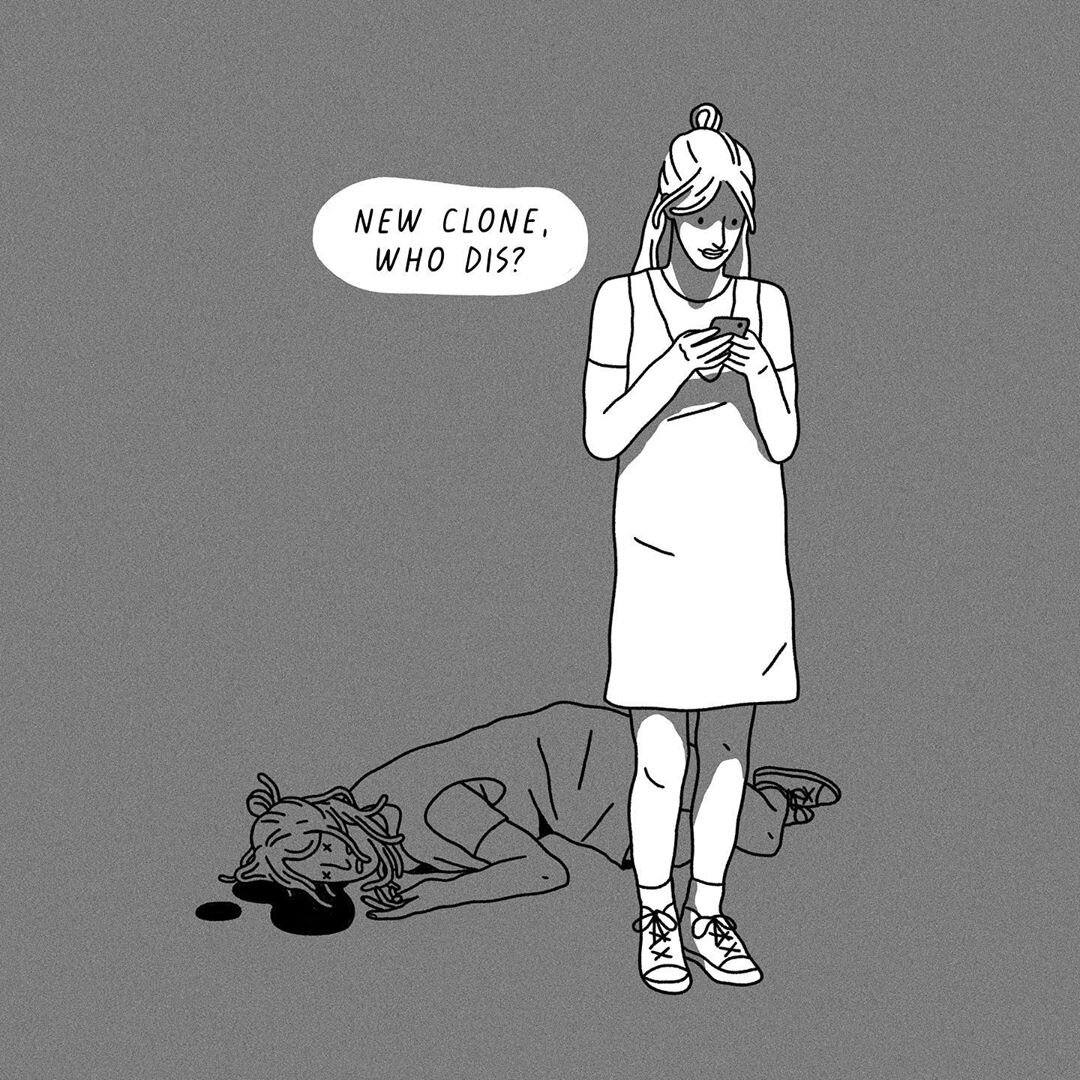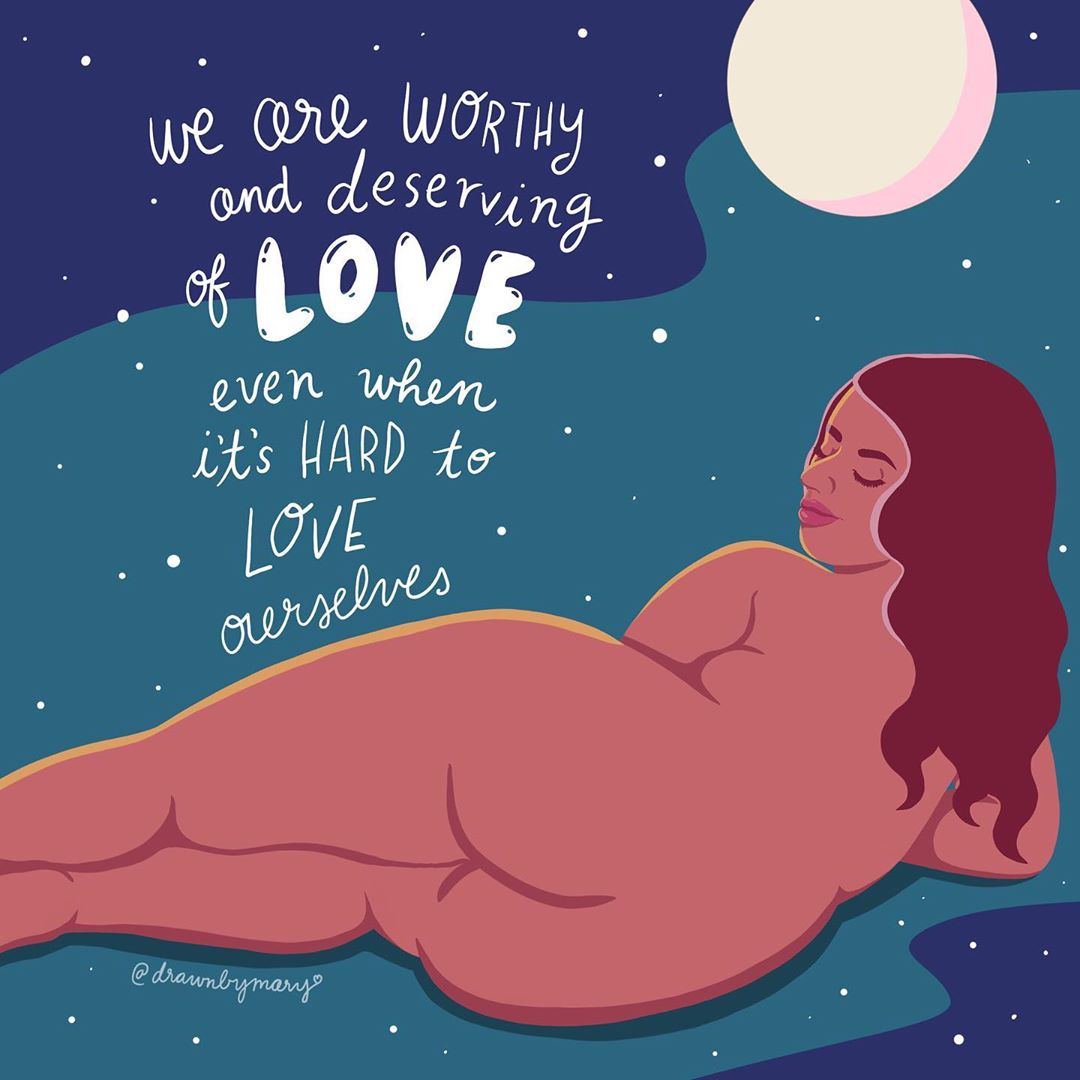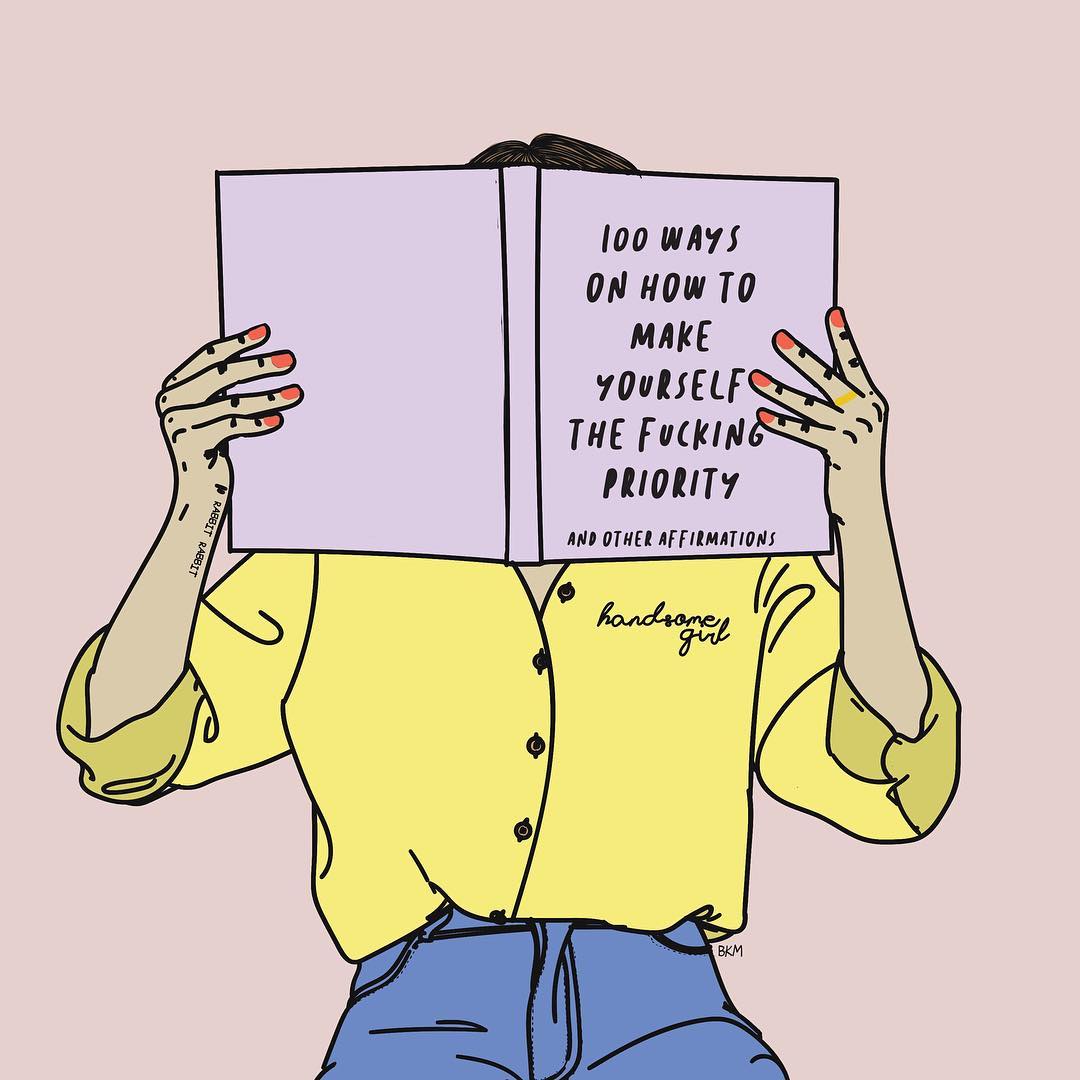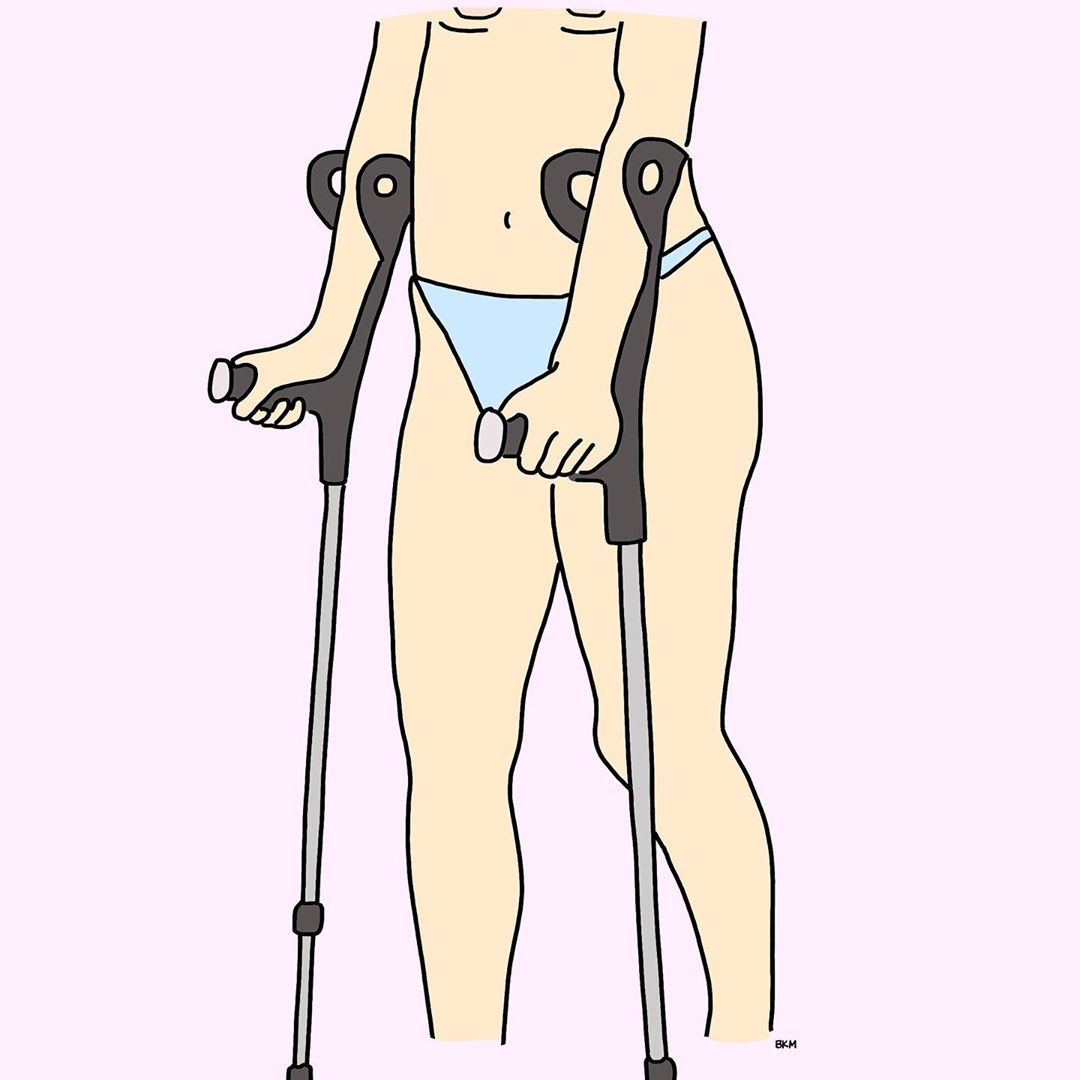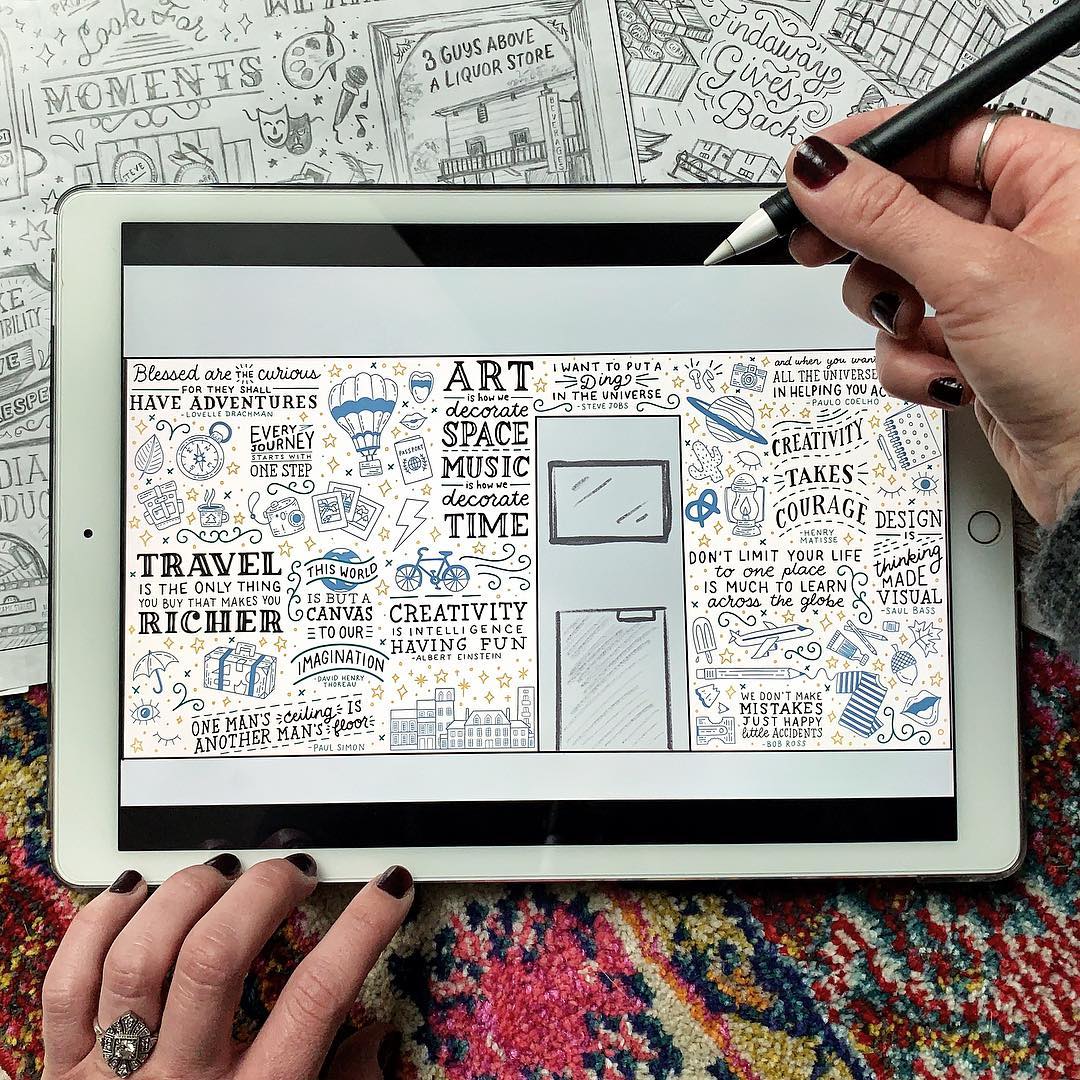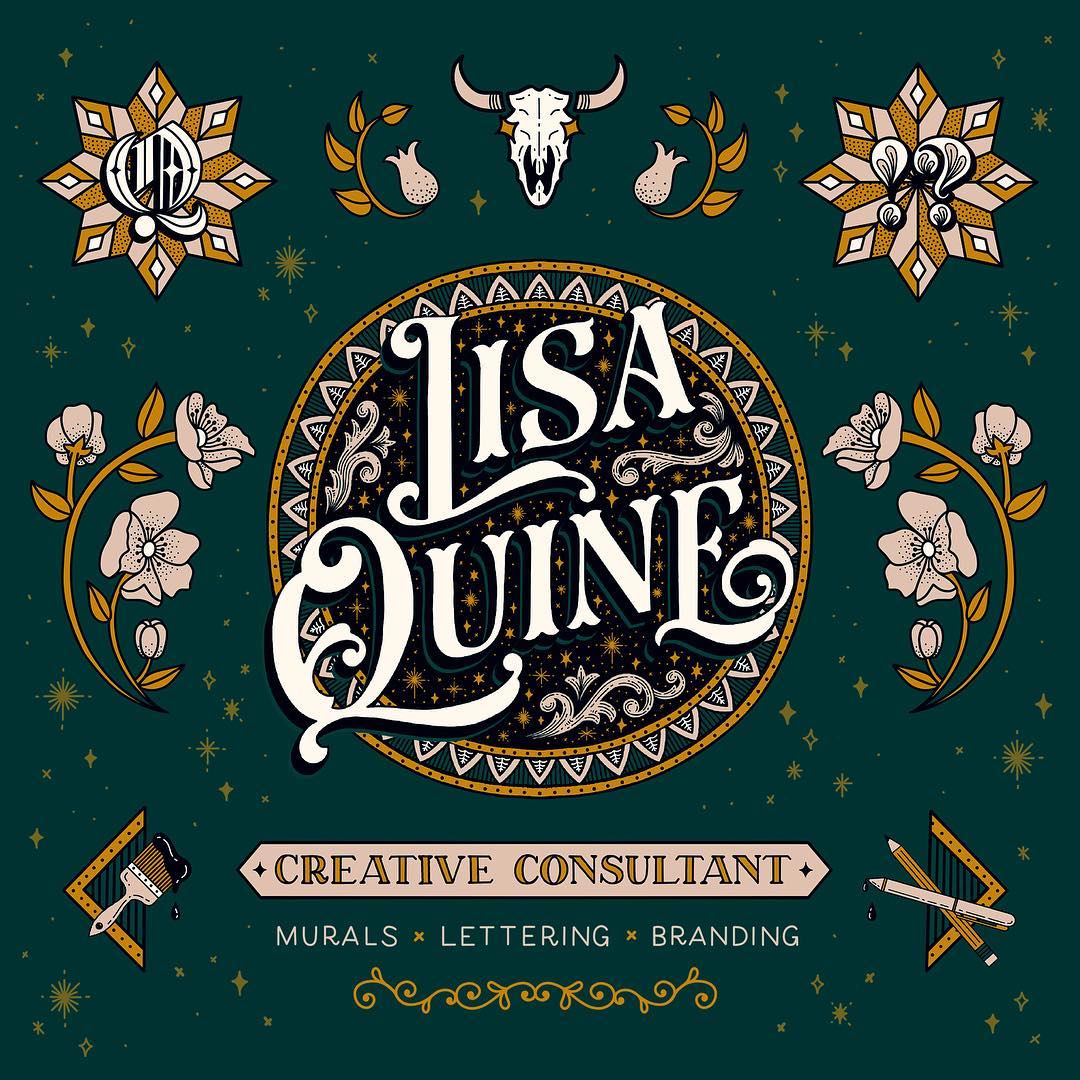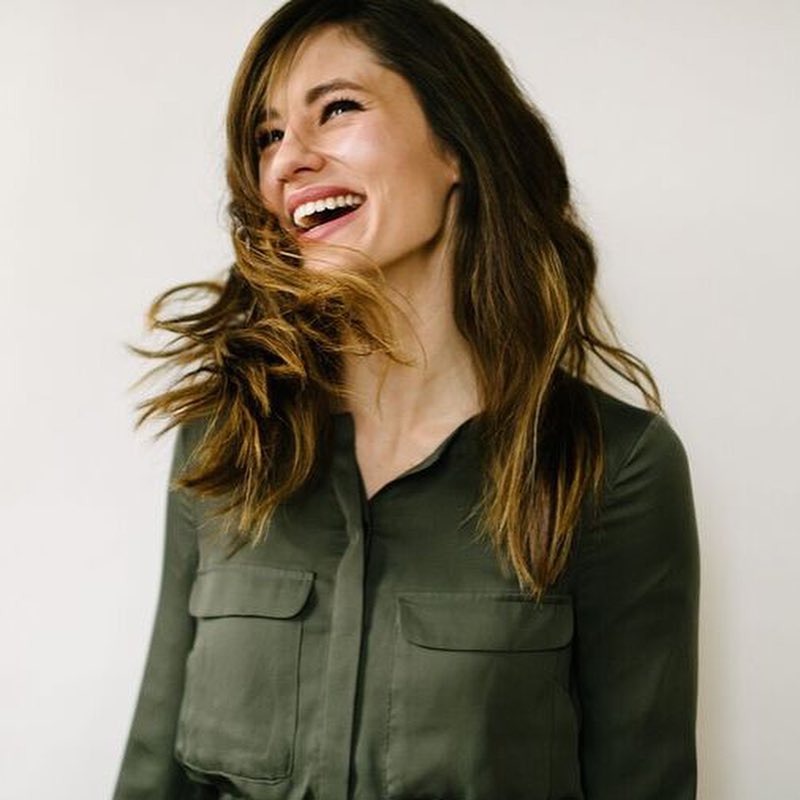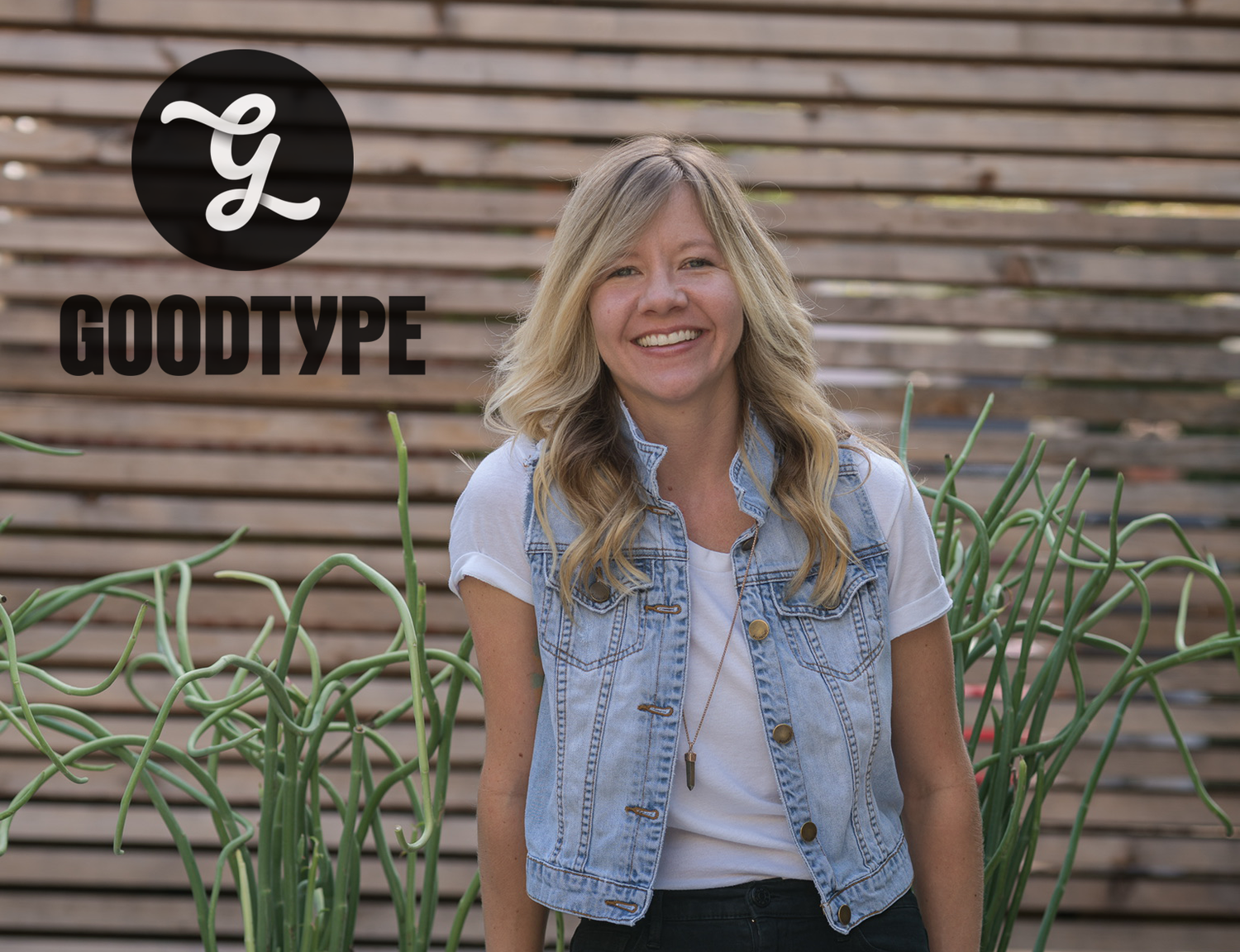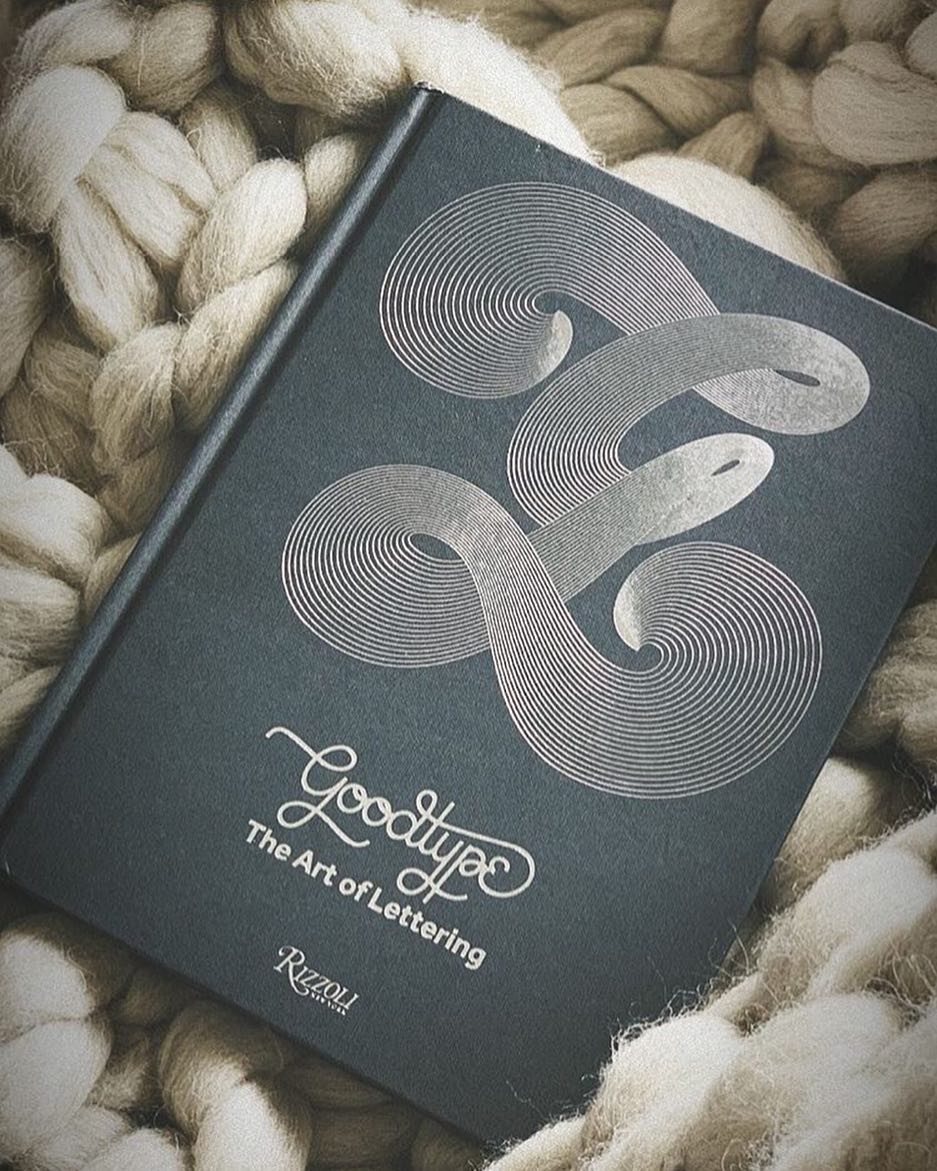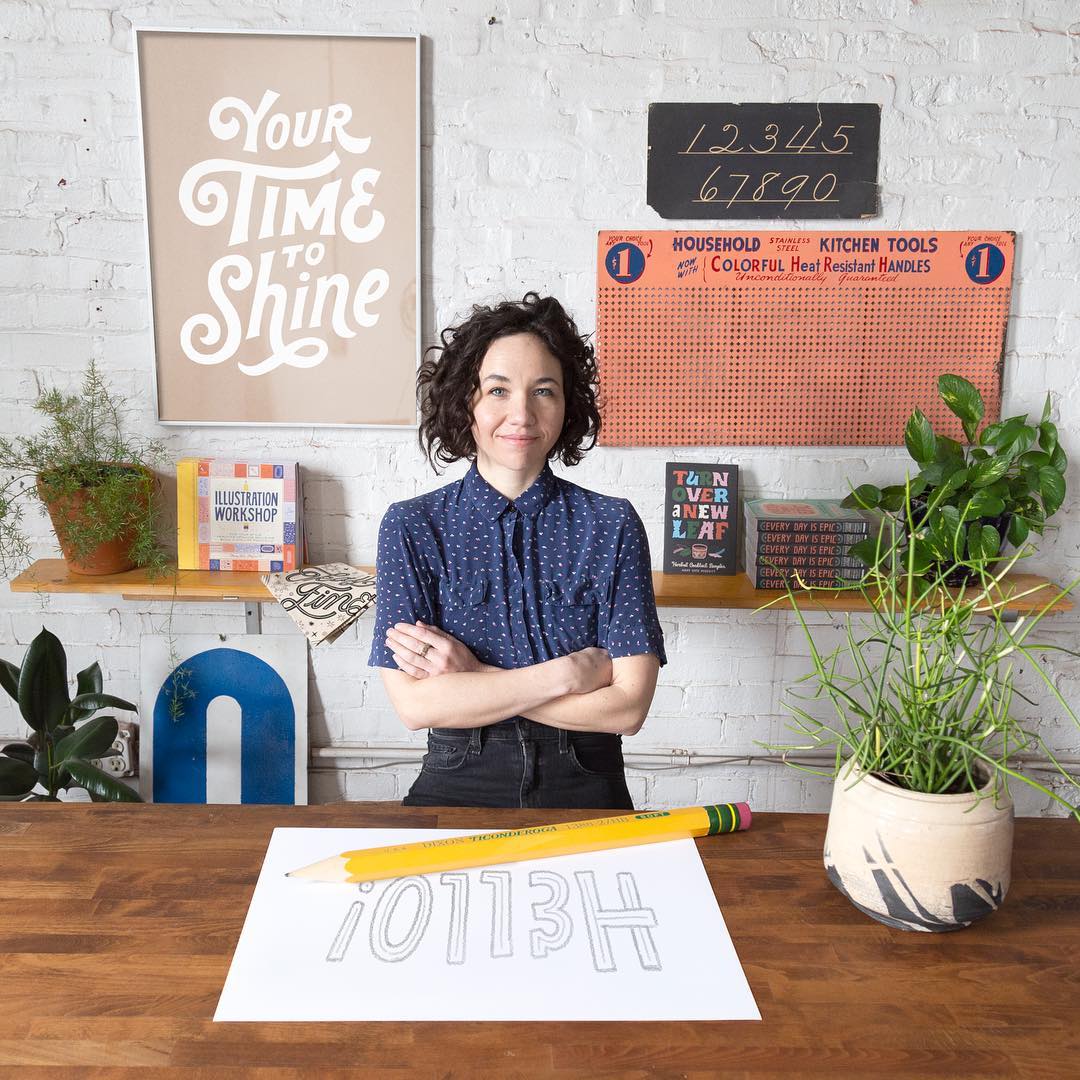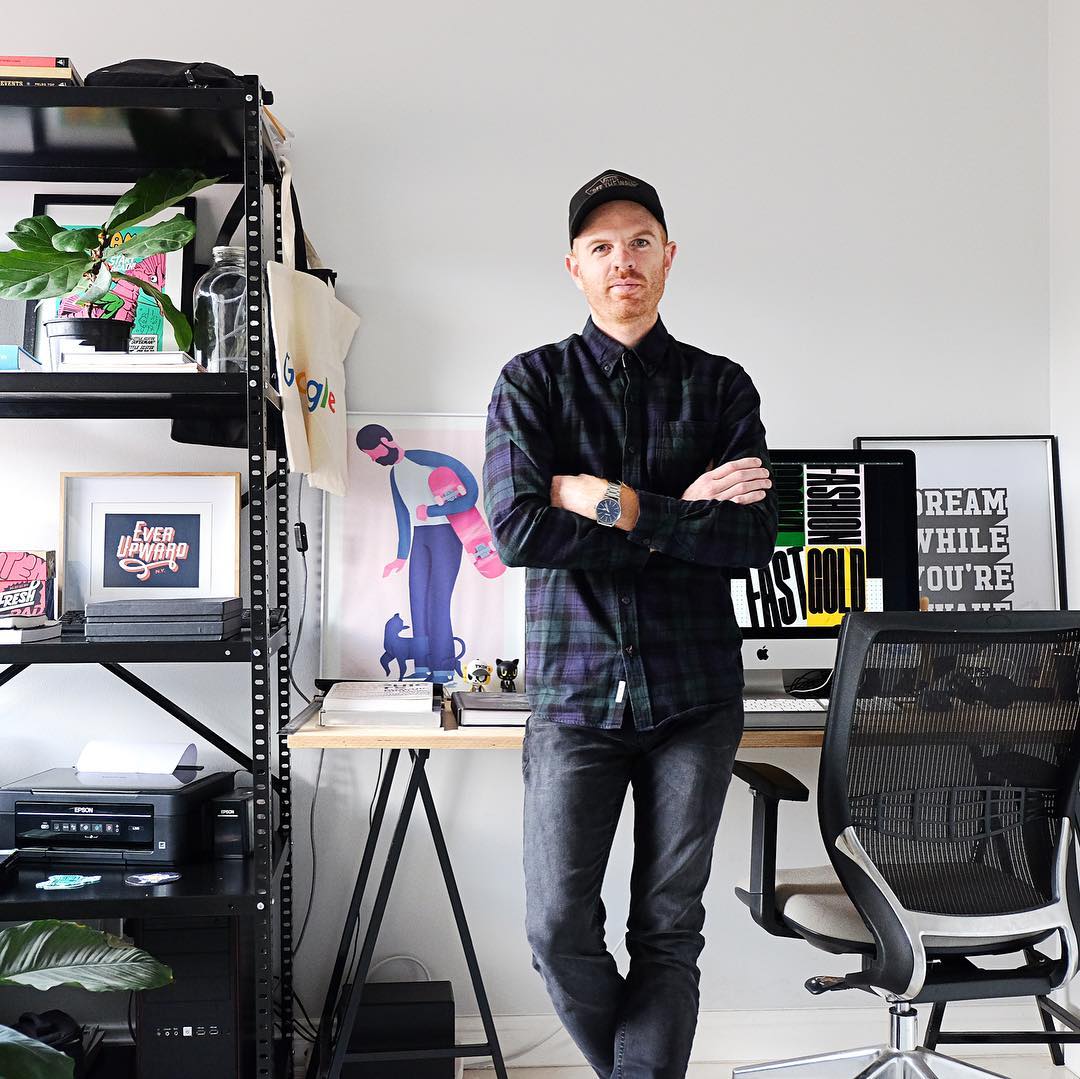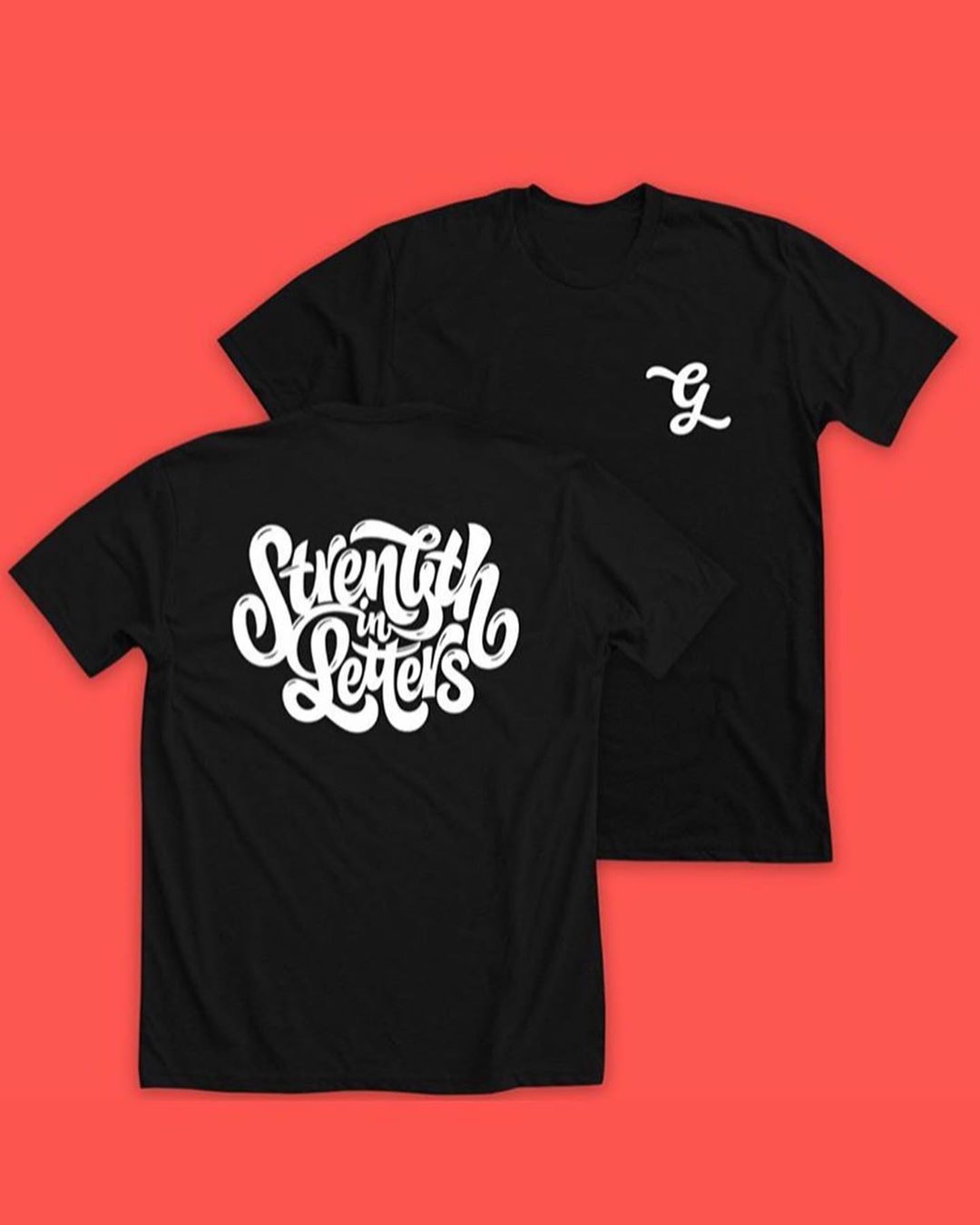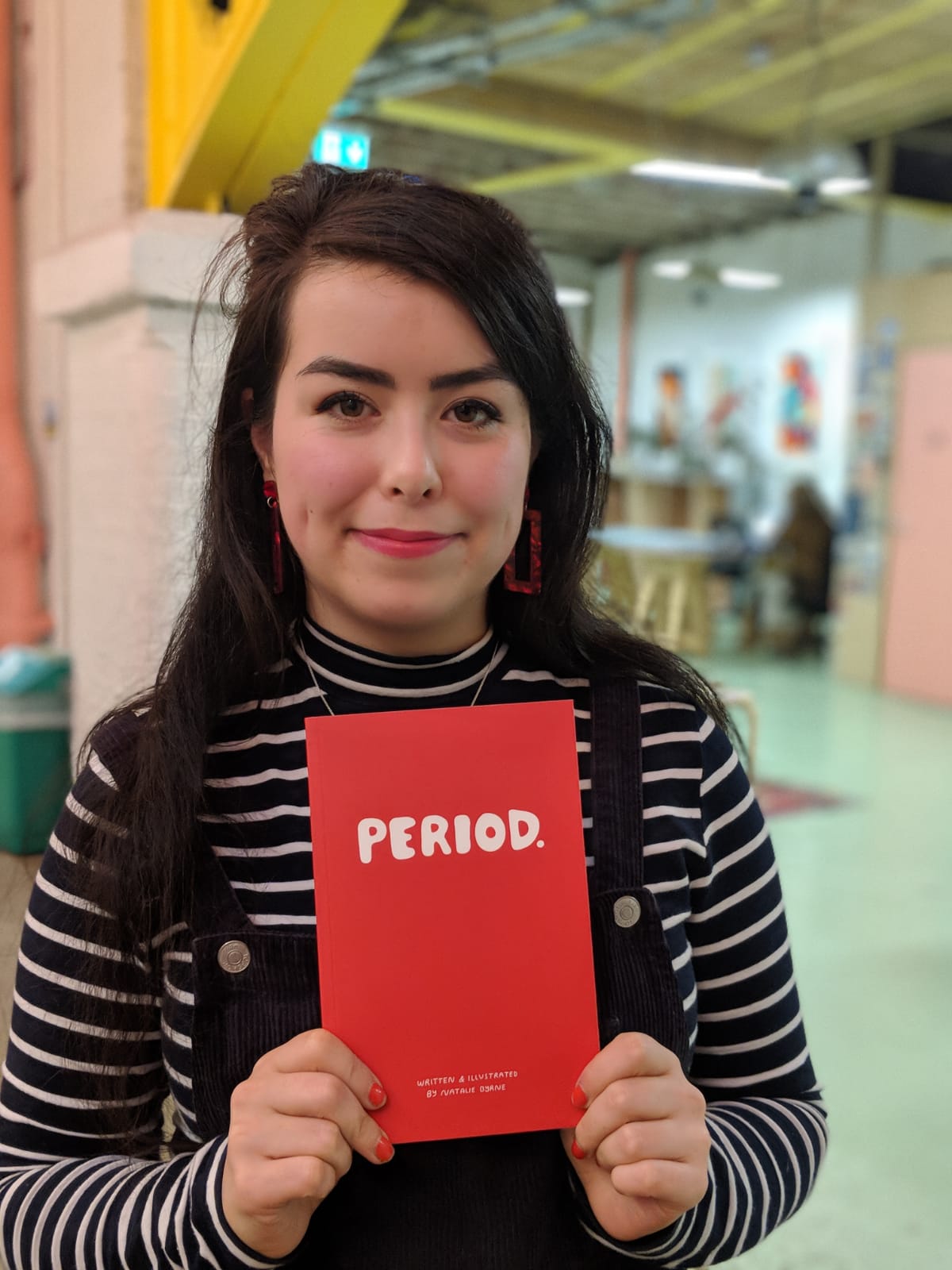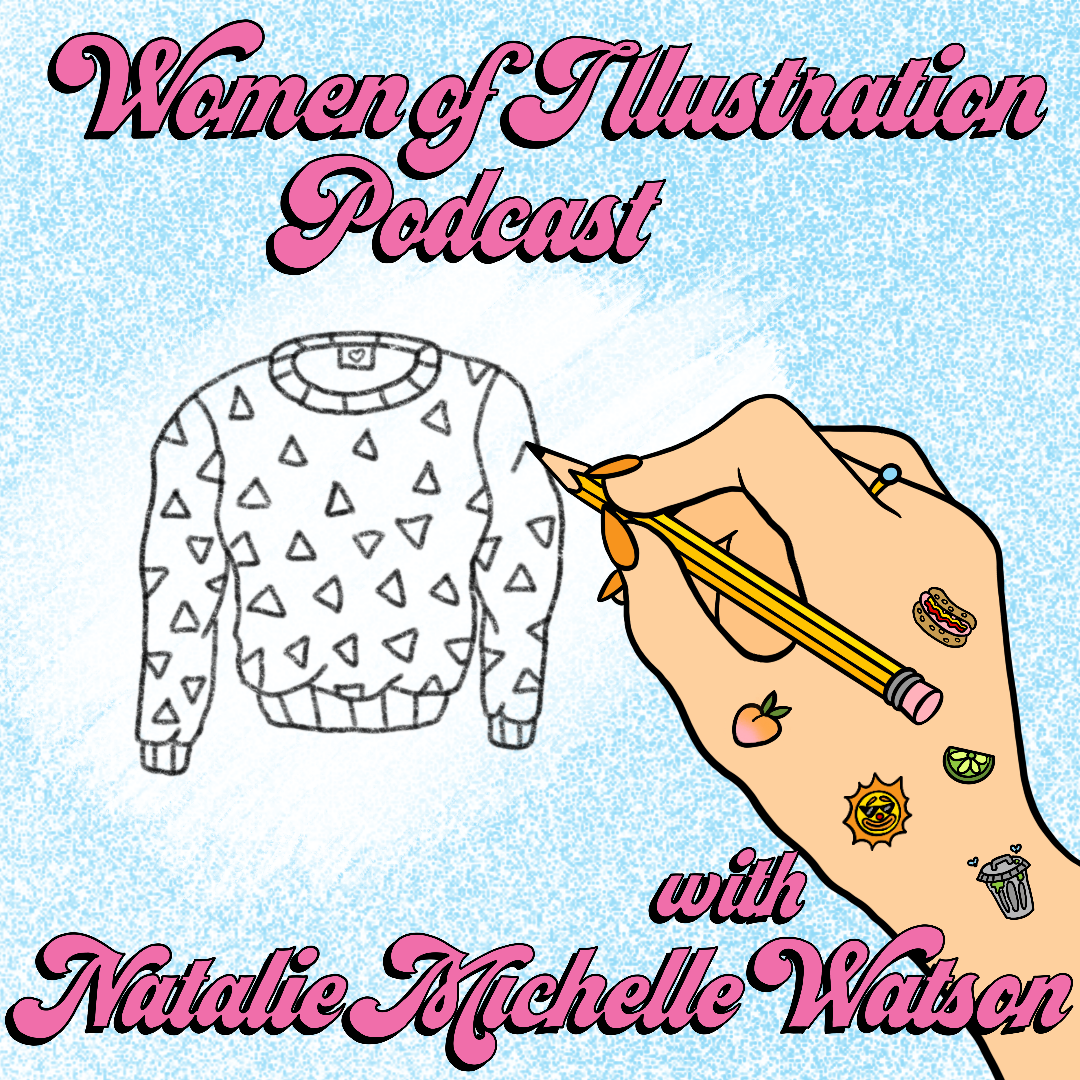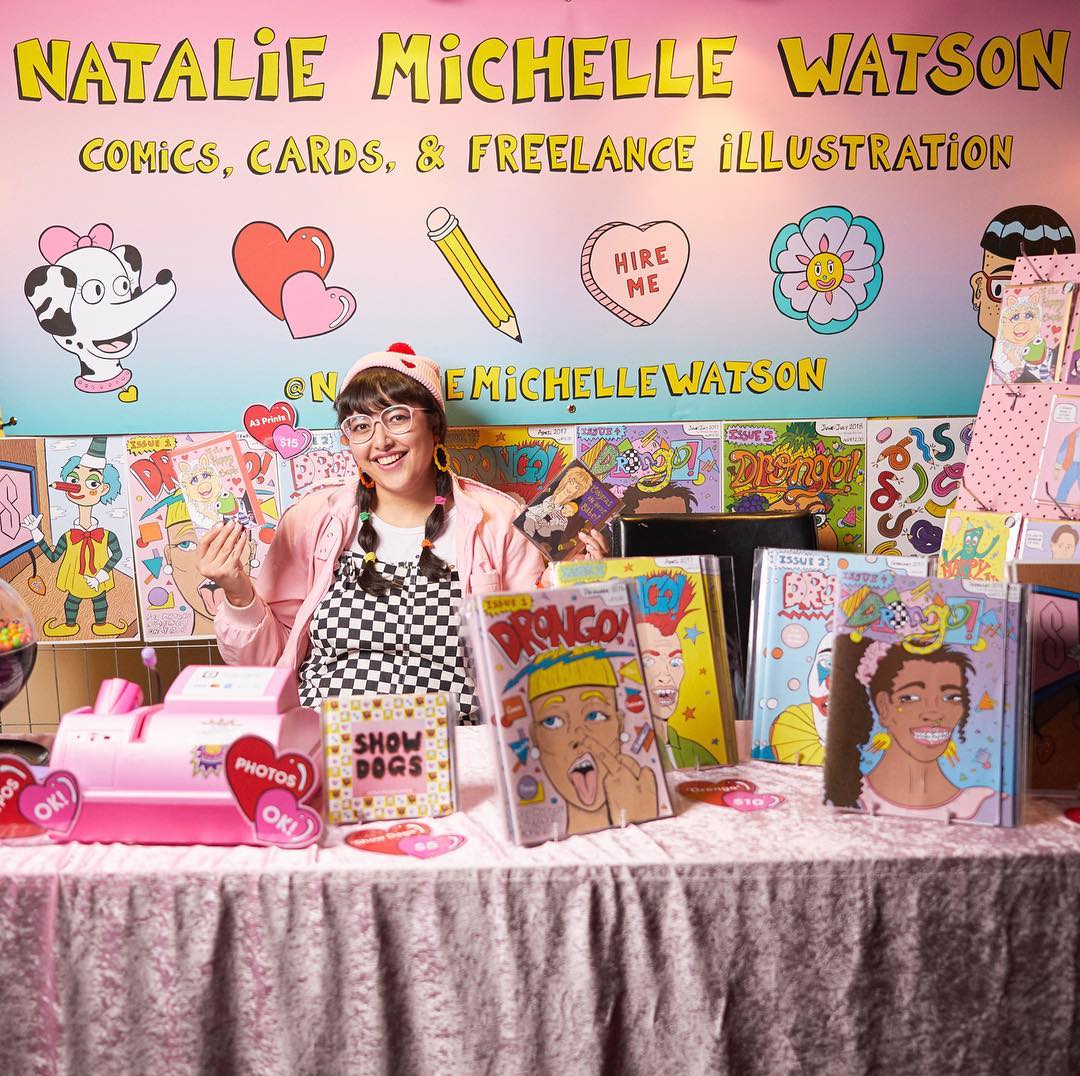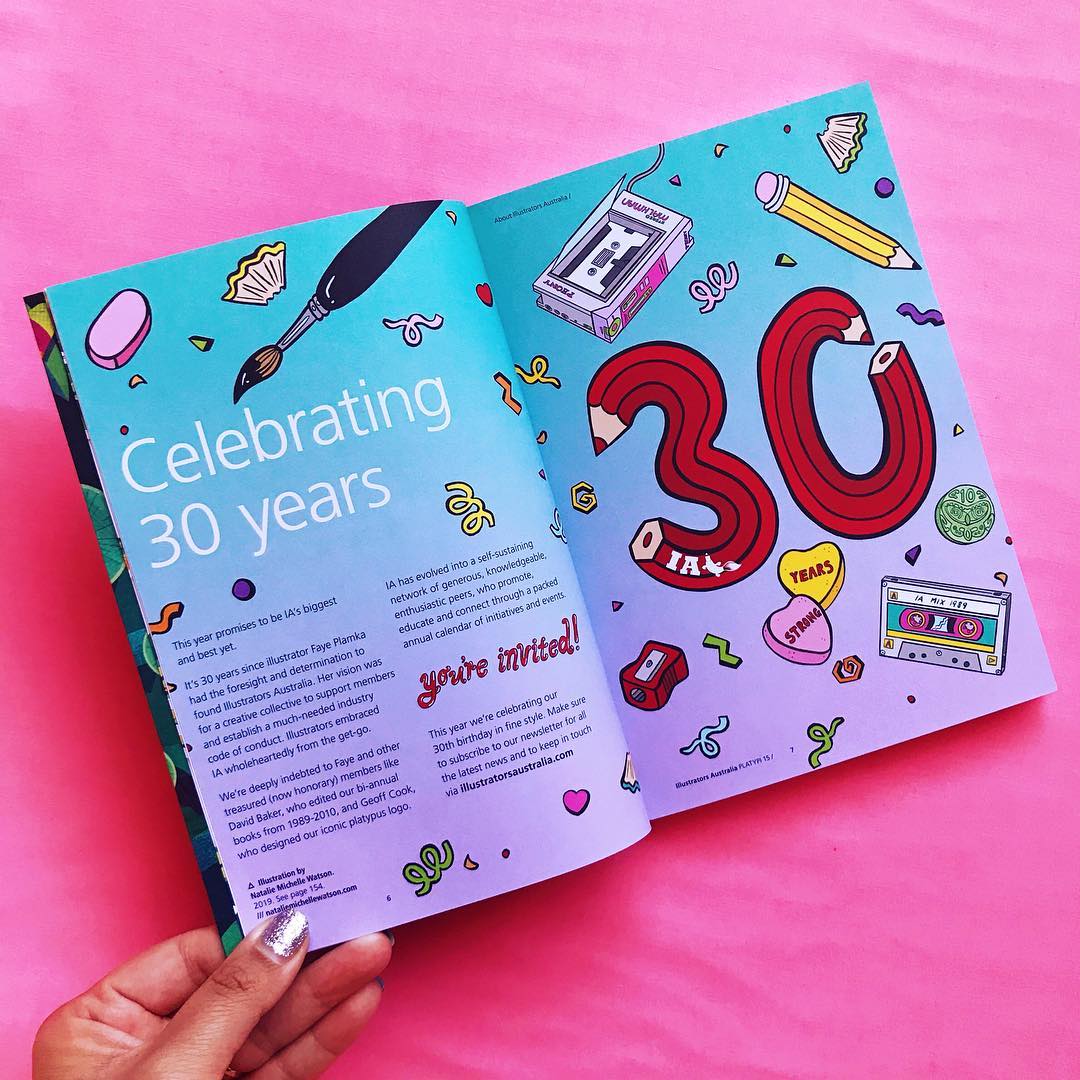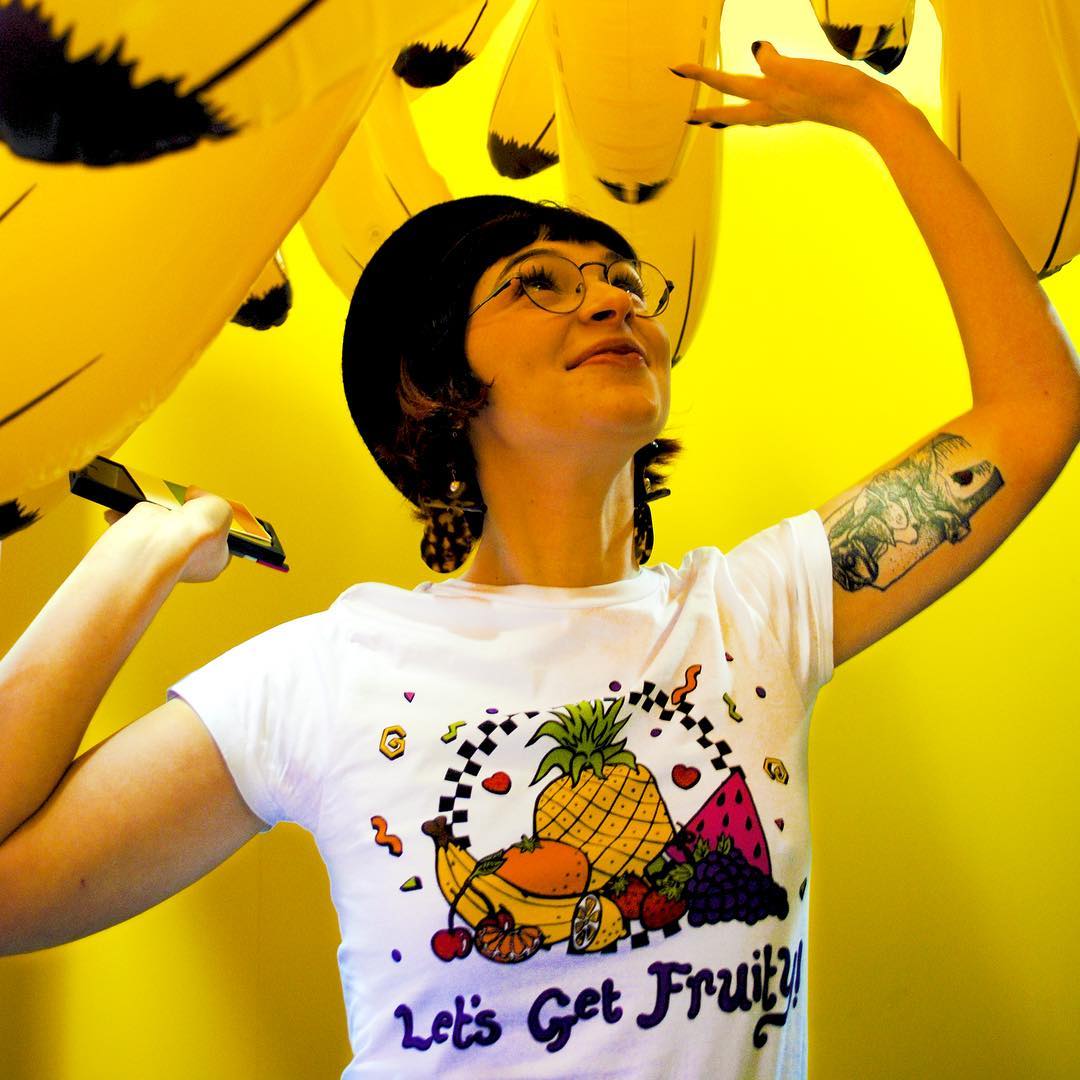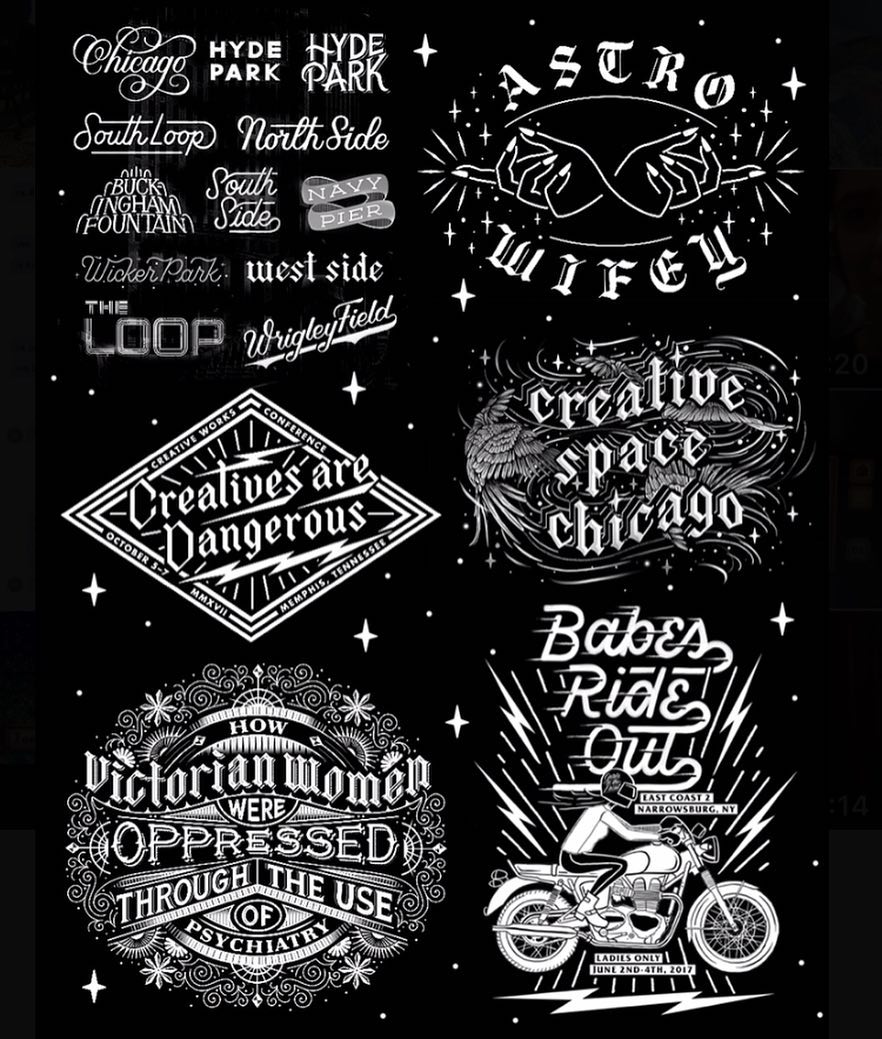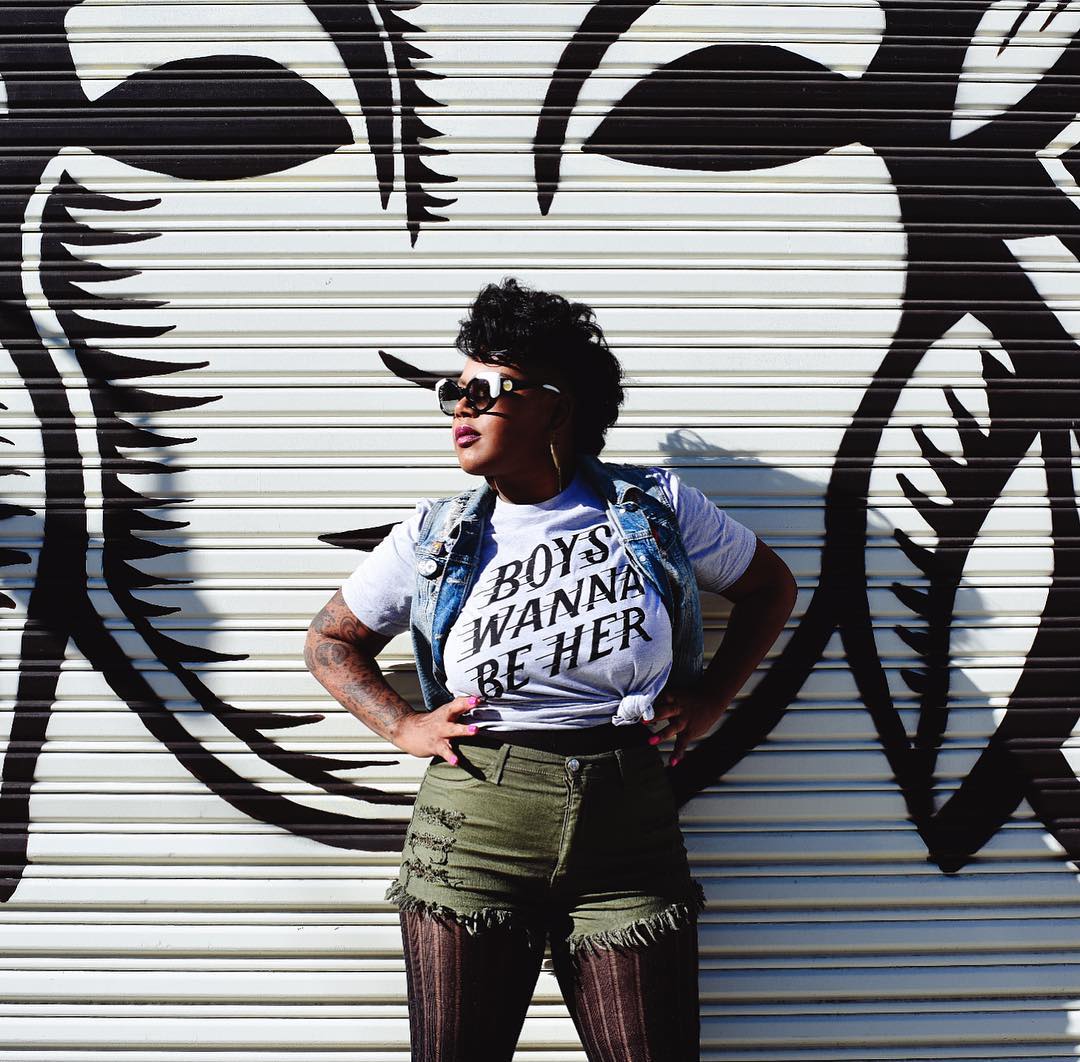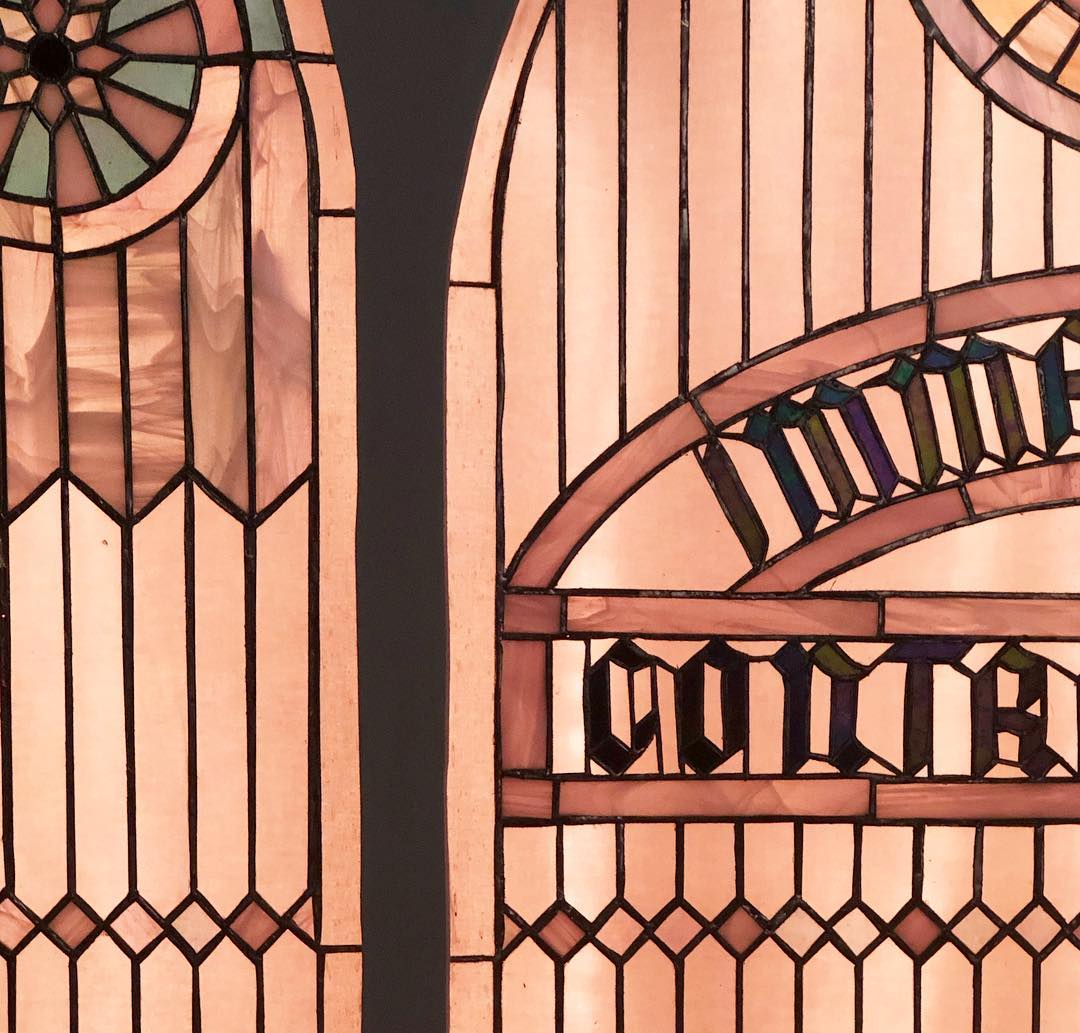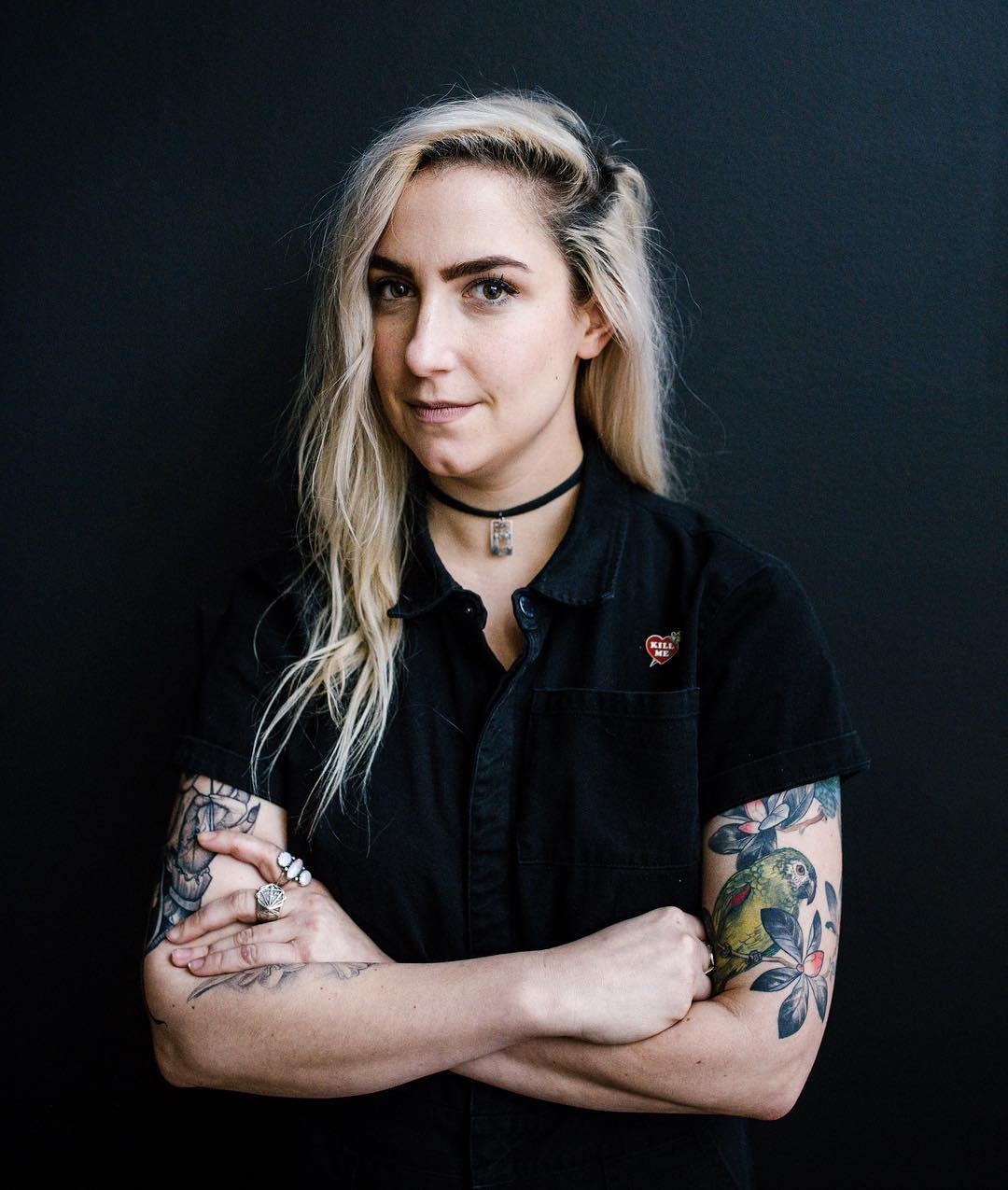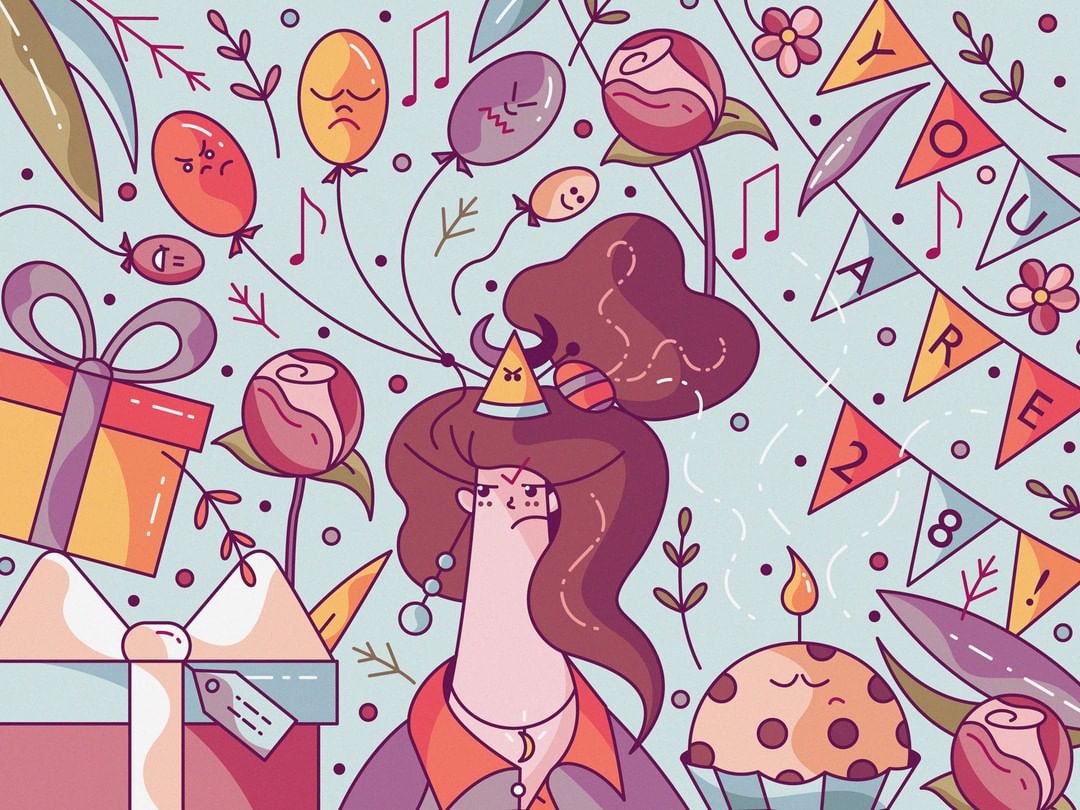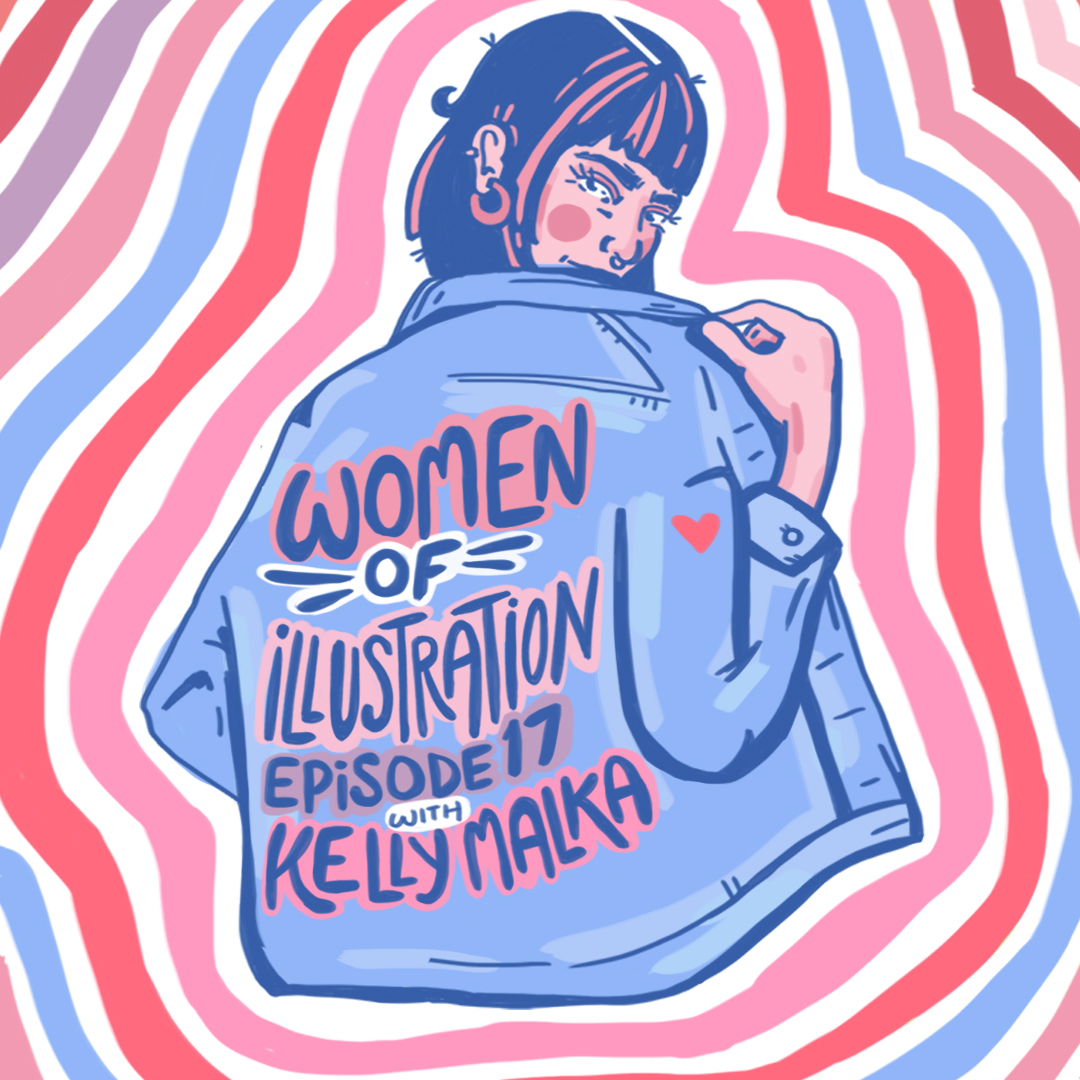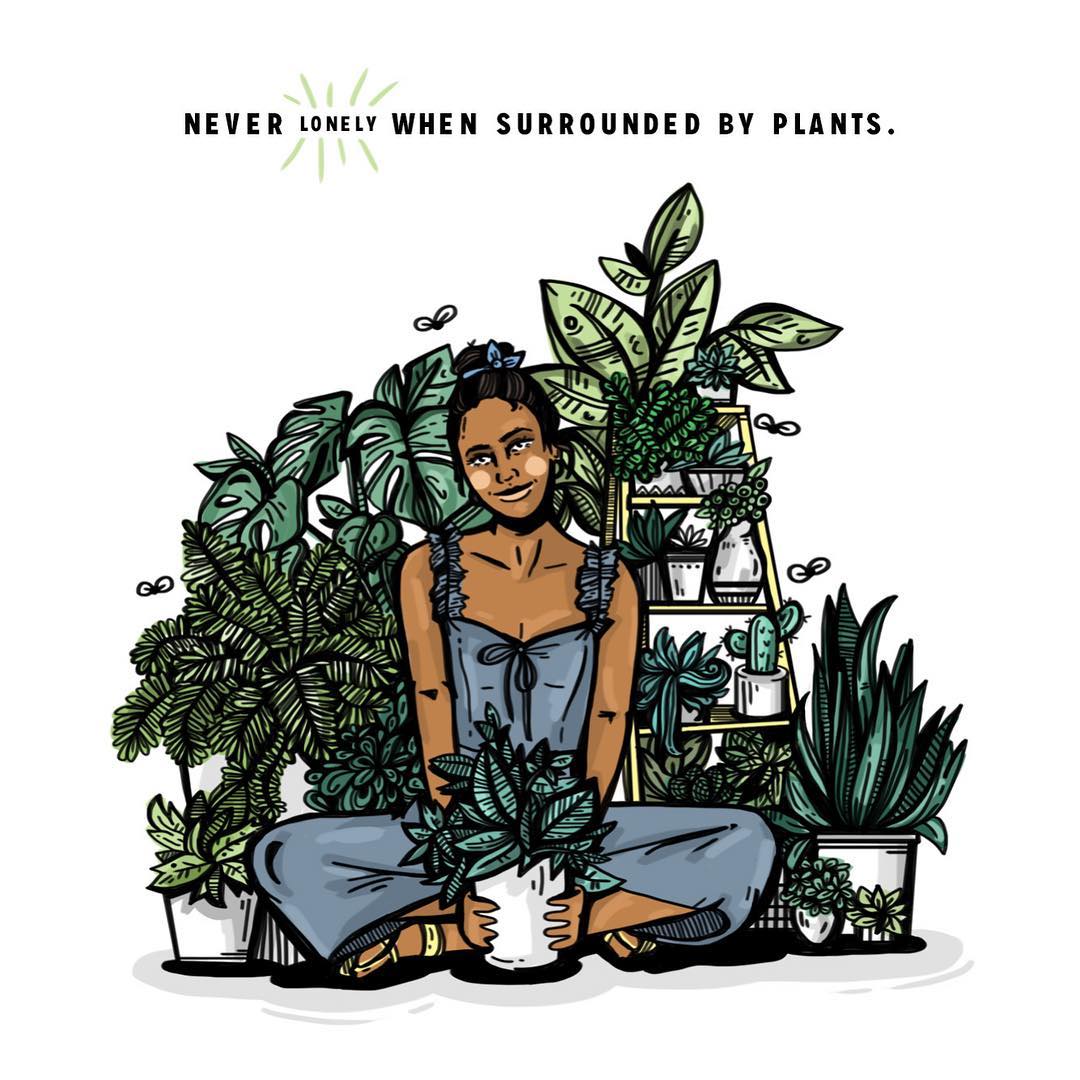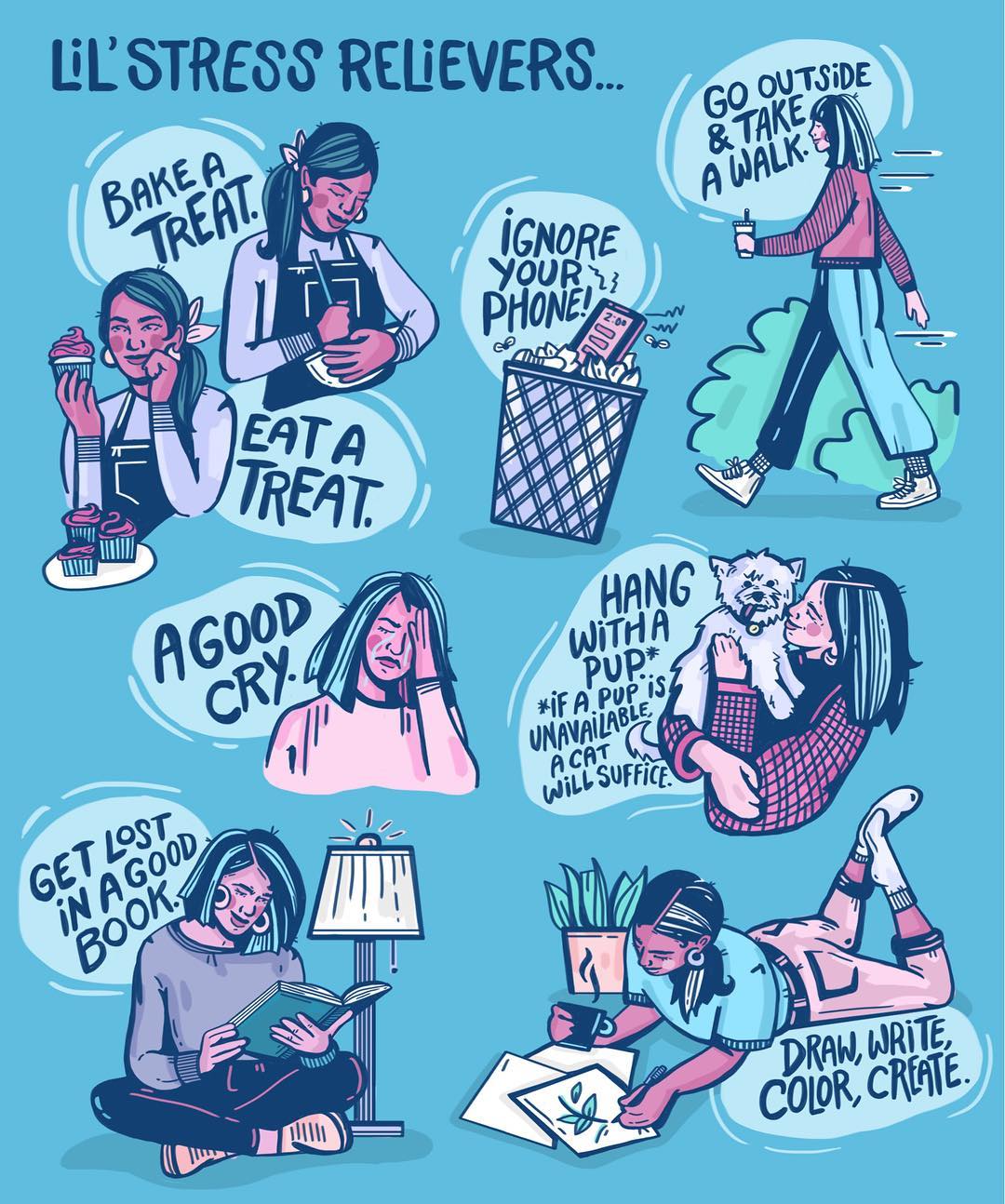Ep 36: How to attract the exact kind of illustration clients you want with Donna Adi
In this episode with illustrator with Donna Adi we go over her exact strategy to finding her fashion niche and working with huge fashion clients like Vogue, Boss, Puma, and Nike. We follow her exact steps to help you attract clients using social media, build your portfolio, and price your work what you’re worth.
In this episode with illustrator with Donna Adi we go over her exact strategy to finding her fashion niche and working with huge fashion clients like Vogue, Boss, Puma, and Nike. We follow her exact steps to help you attract clients using social media, build your portfolio, and price your work what you’re worth.
Follow Donna on all the things.
DONNA ADI
Illustrator
Ep 35: How to prepare to leave your day job for your dream job with Sravya Attaluri
In this episode with illustrator with Sravya Attaluri we go over all the best ways to prepare to leave your day job before you go full-time freelance. How you can build up a side hustle, put money aside, landing your first illustration clients, and getting all your ducks in a row before you give your final notice.
In this episode with illustrator with Sravya Attaluri we go over all the best ways to prepare to leave your day job before you go full-time freelance. How you can build up a side hustle, put money aside, landing your first illustration clients, and getting all your ducks in a row before you give your final notice.
Follow Sravya on all the things:
SRAVYA ATTALURI
Illustrator
Ep 34: Is fan art a waste of time or gold mine with Holly Dunn
In this episode with illustrator Holly Dunn we talk about the benefits of doing fan art along with some of the consequences you might run into when it comes to copyright infringement. Luckily there is a legal way of drawing all of your favorite pop culture references but you will need to find a way to add your own voice into the mix.
In this episode with illustrator Holly Dunn we talk about the benefits of doing fan art along with some of the consequences you might run into when it comes to copyright infringement. Luckily there is a legal way of drawing all of your favorite pop culture references but you will need to find a way to add your own voice into the mix.
Follow Holly on all the things
HOLLY DUNN
Illustrator
Ep 33: How to be self-sufficient with Patreon as an artist with Planet Prudence
In this episode with illustrator Planet Prudence we talk about how you can make the most of Patreon with exclusive content and some creative marketing with a personal touch. With over 700 Patrons and climbing it’s this artist’s goal to be 100% funded by her whopping 700k following using Patreon as her primary source of revenue.
In this episode with illustrator Planet Prudence we talk about how you can make the most of Patreon with exclusive content and some creative marketing with a personal touch. With over 700 Patrons and climbing it’s this artist’s goal to be 100% funded by her whopping 700k following using Patreon as her primary source of revenue.
Follow Prudence on all the things
PLANET PRUDENCE
Illustrator
Ep 32: The secret to completing a 100 day project for artists with Gina McMillen
In this episode with illustrator Gina McMillen we talk about how to gain the confidence to put your work out there and how a 100-day project might just be the answer you have been looking for. We get into the proper planning to ensure you stay consistent and motivated to finish a large ongoing project while getting into some failures and sore spots you’ll hit along the way.
In this episode with illustrator Gina McMillen we talk about how to gain the confidence to put your work out there and how a 100-day project might just be the answer you have been looking for. We get into the proper planning to ensure you stay consistent and motivated to finish a large ongoing project while getting into some failures and sore spots you’ll hit along the way.
GINA MCMILLEN
Illustrator
Ep 30: The pros and cons of running a subscription box with Veronica Dearly
In this episode with illustrator Veronica Dearly we talk about the ins and out of offering new products on a monthly basis to your customs as a subscription box. We go over how Veronica built her audience, markets her products, and makes a deeper connection to the special people that help support every month.
In this episode with illustrator Veronica Dearly we talk about the ins and out of offering new products on a monthly basis to your customs as a subscription box. We go over how Veronica built her audience, markets her products, and makes a deeper connection to the special people that help support every month.
Follow Veronica on all the things:
VERONICA DEARLY
Illustrator
Ep 28: Keeping a career in motion through burnouts and pitfalls with Becca Clason
In this episode with illustrator Becca Clason, we talk about our biggest failures and success stories as full-time artists. We discuss everything from the biggest pitfalls of working with commercial clients to learning how to feel grateful for where you are in your career. Learn from our regretful history so you don’t have to make the same mistake we did getting into illustration.
In this episode with illustrator Becca Clason, we talk about our biggest failures and success stories as full-time artists. We discuss everything from the biggest pitfalls of working with commercial clients to learning how to feel grateful for where you are in your career. Learn from our regretful history so you don’t have to make the same mistake we did getting into illustration.
Follow Becca on all the things:
https://www.instagram.com/beccaclason/
BECCA CLASON
Tactile Lettering
Ep 26: How to find your unique voice as an artist with Sasa Elebea
In this episode with illustrator Sasa Elebea, we help you find your motivation to discover your true self as an artist. We learn how Sasa found her voice, messaging, and how it helped her not only grow her Instagram by over 30k in 6 months but also allowed her to make a full time living from her work.
In this episode with illustrator Sasa Elebea, we help you find your motivation to discover your true self as an artist. We learn how Sasa found her voice, messaging, and how it helped her not only grow her Instagram by over 30k in 6 months but also allowed her to make a full time living from her work.
The biggest takeaway from this episode is how to find your niche by discovering what version of yourself you want to project online. We also get into different ways Sasa diversified her income using Redbubble and Fivver so she could have more freedom in her career.
Follow Sasa on all the things:
https://www.instagram.com/sasa_elebea/
SASA ELEBEA
Illustrator
Ep 25: How to join forces and collaborate with other creatives with My Enemy’s Enemy
In this episode, we chat with the two creatives behind My Enemy’s Enemy a comic collaboration with illustrator Stephanie Davidson and writer Rachel Katz. This creative couple shares their experience working together virtually and how they stay organized to create new content every single week.
In this episode, we chat with the two creatives behind My Enemy’s Enemy a comic collaboration with illustrator Stephanie Davidson and writer Rachel Katz. We often want to work together with other artists we see online but rarely do we follow through. This creative couple shares their experience working together virtually and how they stay organized to create new content every single week.
Follow them on all the things:
MY ENEMY’S ENEMY
Illustrator & Writer Team
Ep 24: Getting hired and avoiding nightmare illustration clients with Mary Purdie
In this episode with illustrator Mary Purdie, we will share stories from our best and worst clients and what we learned from each. We cover everything from our opinions on doing free work to how to turn down a project without being rude.
In this episode with illustrator Mary Purdie, we will share stories from our best and worst clients and what we learned from each. We cover everything from our opinions on doing free work to how to turn down a project without being rude.
Sometimes it’s hard to figure out whether or not a project will be a worth wild effort, but at the end of the day you just gotta follow your gut. You have to learn to read the major red flags for nightmare clients so you can find peace in your freelance life.
Follow Mary on all the things:
https://www.instagram.com/drawnbymary
MARY PURDIE
Illustrator
Ep 23: How to overcome Instagram trolls with Bridget Moore
Bridget runs a full-time side hustle in illustration called Handsome Girl Designs that focuses on body-positivity and feminism. Handling online negativity is something she sees on a regular basis, so read on to learn some techniques she uses to endure and combat the instigators.
Bridget runs a full-time side hustle in illustration called Handsome Girl Designs that focuses on body-positivity and feminism. Handling online negativity is something she sees on a regular basis, so read on to learn some techniques she uses to endure and combat the instigators.
How long have you been at your day job?
I worked for a couple of years starting in 2015, left for nine months to work solely in design, and came back to merchandising. I missed my team of coworkers, which is what really made me want to come back. I have a rad team and we’re like a family.
What are some of your duties at your day job?
In music I have specific clients, such as Bon Jovi. If you go into a retail shop and see a tee-shirt with a Bon Jovi design on it, my team created it and made it come to market. I also work with many influencers, Vanessa J Simmons and I worked together to create a Mommy and Me clothing line. I make clothing concepts come to life in the market for many different people. There are some celebrity clients that are thankless, meanwhile others are humble and grateful for the work that I do. The scope of the projects I get to work on is amazing, which always keep things interesting.
How does your day job influence creating projects for yourself?
Handsome Girl Designs came to life as an outlet for my creative freedom. At work I am creating for people. I have to get their approval and edits, so when it’s finished, it’s not just my work. I just wanted to create things in a space where I have complete control and creative freedom. A deeper part of it, especially with the body-positivity aspect, was that it helped me illustrate my struggles with my eating disorder. Drawing parts of my body that I don’t love in a celebratory way helped me realize that my imperfections are beautiful. It’s a fulfilling project and it’s a plus that I am my own boss.
Talking about these types of social issues and female empowerment guarantees the occasional troll, how often does this happen?
It happens about 90% of the time. It’s mind-blowing what people feel comfortable saying online. I think some people are out there are truly trying to defend their opinions on a particular issue. One time, I illustrated a pizza slice that read “a slice a day keeps the sad away,” and I got so many comments about creating a better diet for myself so that I’m not “fat.” These are the type of people who believe they are being helpful, but it’s crazy because they are judging me based off of this illustration, not knowing what I actually look like. Then, there are others who are just bored and looking to piss people off. A lot of times, when I click on a troll’s profile, they’re just teenage boys.
What do you think some of the motivation that trolls have are?
When people are being negative towards you in a non-constructive way, it’s the “misery loves company” mindset. Making other people miserable is the only way some people are able to feel good about themselves and less alone. When these trolls see people empowering themselves and others through vocalizing their struggles, they want to bring you back down to their level. They don’t want to see you surrounding yourself with a positive community, getting the help you need, and rising out of that hole.
What’s your reaction when someone leaves a negative comment for you?
If it comes on a day that I have lost progress with my eating disorder, my confidence, and my body, it can hit me so hard. I will want to dive back into my bad habits. So, I will want to restrict my eating habits in order to regain some control where that comment took control away from me.
On the flip side of that, there are days when I rage and say “fuck this,” and let that rage power me through my illustrations. I wish that I could have that reaction every time, but I’m only human and sometimes the trolls really rattle me.
What’s your policy on responding to trolls?
It depends on the situation. I always check their profile to see if they are a legitimate account with more than a handful of followers and offensive posts. If their account reflects their rude comment, I will block them because it’s clear that they are trying to instigate.
If their account is more legitimate and they are just making a clownish comments, I’ll play back. I’ll say something like “Oh, gee thanks. What a helpful comment.” I want to acknowledge it and let them know that they are being an asshole.
If it’s a legitimate account and they are criticizing me or my work, because it triggered something in them, I will always respond. I appreciate that feedback, because my intent is never to produce negativity. I take these types of comments as constructive criticism, but also don’t take them to heart, because oftentimes it’s over unshared opinions and different ideology. My art reflects the way I feel and people are not always going to agree with those feelings. I leave those critiques up, and they don’t really affect me.
However, if someone posts a slur, a threat, or something morally offensive, I delete them, block them, and report them. There is no need for hostility and I don’t want it on my page.
Do you think there is room in the art world for conversations about this subject matter?
Yes! There cannot be enough dialogue about this disruption. There is an awesome ripple effect of positivity that I see radiating from my account to the accounts of others. We need that type of community where there is a safe space on the internet for feminist creatives. To have a little corner where you know allies will back you up in a comment against a troll is so important.
How do you overcome trolls and keep making things that you believe in?
My sister once told me this Andy Warhol quote: Don’t pay attention to what they write about you, just measure it in inches. This is so tangible, especially on Instagram. You can literally measure the comments and gauge the impact that your art had on them. It doesn't matter if it’s a positive or negative comment; you can see that something that you created struck them in some way. All artists should hold this idea close to their heart. It has helped a lot, particularly on the days I get a lot of mixed feedback.
What advice would you give to an artist who wants to tackle similar issues through their work?
Just do it. For the amount of trolls I get, there is more love and support that my art gets. The troll comments can hold a little bit more weight than the positive comments do, but at the end of the day the encouragement really keeps me going. There is somebody on Instagram waiting for you to create something they can relate to.
In my series “Babes” I started illustrating lives that I don’t lead, such as women disabilities and women who self harm/harmed. I went back and forth deciding if should post them after drawing it out. These my stories and I wasn’t sure if I should be the one to tell them. I finally got to a point where I realized that it doesn’t matter because I know these women and I want to celebrate them. When I finally posted them I got so much support and thanks for making my art more inclusive. I think it’s time to push through the doubts and put it out there. There will be people who bring negativity, but you are going to help somebody. It can have the power to change someone’s day.
What’s the worst experience you’ve had with a troll?
I made a post that said “Anything you can do, I can do bleeding” and a lot of straight men had issues with it. They read that quote as “Anything you can do, I can do better,” and decided there was room for argument. I got so many troll comments for that one, but there was one guy in particular that got a rise out of me. He started by saying that it’s scientifically proven that men are better than women. So, I decided to play back and said “I’m so bummed that I missed that riveting article.” Then, he decided that he didn’t like my playful response and escalated to slut-shaming me, which then turned into racial slurs.
I quickly blocked and reported him and deleted the comments as they came, but he created new accounts to harass me on. He then proceeded to DM me and email me. He sent me a picture of his dick and said “I could slice this open and still do things better than you.” He was messaging me ten to twelve times a day, got my email adress, and began threatening me with rape. After a week of this, I finally had to report him to the cops and it stopped.
What’s the best response you’ve gotten from your art?
There is a lot from me to choose from, because I get many DMs from people who are stoked about a piece that I did. This one girl really sticks out though. I posted an illustration of a woman with an amputated leg, and this girl’s friend tagged her in the comments because she had just undergone an amputation. Still hospitalized from the procedure, she messaged me to express her appreciation of the visibility that I brought to her situation and to let me know that through my post, she had found other accounts that did too.
It touched my heart knowing that I was a small cog in the wheel that brought a moment of hope during a terrible time in her life. My interaction with her really opened my eyes to the fact that I should be making art that includes even more diversity. She helped me just as much as I hope that I helped her in that moment.
Do you have any upcoming work that we can help promote?
Following and engaging with me on Instagram is the most immediate way to support me. If you are in the LA area, I will be having my first art show at the Earth Altar Studio in Eagle Rock. My art will be up all through the end of summer and the studio is a cool tattoo shop that you should check out anyway!
BRIDGET MOORE
Illustrator
THIS ARTICLE WAS WRITTEN BY OUR AMAZING VOLUNTEER
Aysia Jay - Show Note Writer
Freelance Writer | Website
Based in New Mexico
Ep 22: How to become a professional mural artist with Lisa Quine
Lisa Quine, lettering artist, muralist, speaker, and designer, takes a deep dive into how to become a successful muralist. She discusses her process, biggest failures, learning experiences, and much more.
Lisa Quine, lettering artist, muralist, speaker, and designer, takes a deep dive into how to become a successful muralist. She discusses her process, biggest failures, learning experiences, and much more.
Out of everything you could have chosen to do as a lettering artist, why did you pursue murals?
I don’t feel like I am pursuing murals. They just happen to be the work that I am getting and saying “yes” to. I got one mural project, which led to two more mural projects, and it grew from there. Cleveland is a big city with such a small town feel because everyone knows everyone, so the network here is insane. It’s like you throw a rock and you get a mural project.
What was your first mural project like?
One of my coworkers at an advertising corporation I worked at had a girlfriend who was with a company called Find A Way. The company was looking to get a four-wall mural piece installed in their lobby. They asked me to hand-letter a quote and draw an ice cream truck as my audition, so I did it and sent it over. A couple of months later, I heard back and they liked my style. They gave me a list of 100 items that they wanted me to include on the mural. This was before the iPad and digital work, so I got the measurements of the wall, drew a box on InDesign ,printed it out, and tried to fill the four squares with 100 items.
The lobby was too narrow for me to use projection and I was too lazy to grid it out, so I just improvised. I drew everything out in pencil first and then inked it in with Krink Paint Markers. I had no idea what I was doing, but it was perfect because there were so many items, so if I messed one up it would be camouflaged.
I posted the crap out of that project and a lot of people saw it on Instagram, Facebook, and in person. I learned so much from that experience and I am so grateful for it.
What is your mural design process?
I get emails about different potential mural requests. It starts with wide inquiries, for example, let’s say a store wants a window display. I’ll give them three prices based on a temporary window display, because I have different rates for different things. If they want a simple quote like “Coming Soon…” or “On Sale” that will be around twelve dollars per square foot. The next level up for more detailed typography with a couple of illustrations would be fourteen dollars per square foot. The next tier would be sixteen dollars per square foot.
I play with those numbers depending on what seems fair to both me and the client. If I can decide on a certain rate, I’ll send it to a trusted friend for a second opinion on the quote. People always ask what the differences are for each tier, and even though I explain it in the quote, it’s better for them to visualize things. I use Pinterest to provide a visual example of what each one might look like and put it in a PDF. When people ask me to price out a mural, I give them the breakdown on the three tiers and the PDF showing the differences.
After they pick a tier, I will create a mood board if they don’t know what they want. Sometimes they already have photos of things they are gravitating towards. Then, we have am in depth conversation on why those chose those pictures, whether its the colors, the style, etc. I try to see what they inspiration is and form an idea in my mind.
I’ll take what we discussed in that brainstorm session and sketch it up on the iPad. I’ll send it off to the client and we will go back and forth until we are both satisfied. Most times, they’ll see my first draft and be satisfied and excited. Although, I do warn them that the real mural is guaranteed to look a little different than the sketch photoshopped on the wall.
Once I am ready to start on the mural, I will do one of three things: wing it, grid it out, or project the design. If it’s in a tight hallway, I’ll grid it out. If it’s a small design I’ll wing it. If I can use a projector, I always will, because it makes the project easy. Then I am ready to paint
How many concepts do you give to the client on average?
It’s usually just one concept where I show them what I am most excited about and they like it. Normally, when people want a mural they don’t know exactly what they want it to look like, so when I show them a sketch it’s a good point to start from. I’ll show them a pencil sketch without color and see if they like the direction. Normally, the first revision is what they want and we’ll add color and go from there.
If someone’s goal is to do murals, what is your best social media advice?
Being open with people about your process, like posting a picture of your supplies or work in progress shots. Being real with your audience is so important, don’t show just the finished piece, because it’s less relatable. All this helps your audience get excited for the final draft, because they’re following you on your journey.
Inserting yourself in your posts helps too. When you put a person in the photo, it gives your audience something they can connect with. I have noticed that I get more interaction on posts that I am in, compared to the posts that are solely my art.
What do you think is an appropriate amount of posts per mural project?
I usually do two to three, but it’s important to know what works best for your audience. I will do an in process, a final, and maybe a time-lapse. The nice thing about murals is that people take pictures in front of them, so it’s like endless content material and marketing.
How do you get big clients like Target, Harley, and Kohl’s, and what kind of work do you do for them?
I worked with Target when I was fully employed in advertising. I was found by company from Seattle that recruits artists to design stationary and then pitches the illustrations to businesses like Target, Starbucks, and a few more. Over the course of a year, I had lettered a couple of quotes that could go on a journal cover. They pitched it to Target, and months later, I found out that they liked the work and wanted to hire me. I had to learn so much, because it was my first big project and I didn’t negotiate the terms.
I met Joe, my Harley contact, at Weapons of Mass Creation in Cleveland. I found out that he works with Harley Davidson and I was able to use that network to land a gig with them. It’s so important to make personal connections and the best way to do that is in person.
For Kohl’s, my network in the advertising world led me that job. They were looking to hire a last-minute illustrator, and old colleague of mine recommended me for the job. I ended up lettering “It’s 5 am somewhere” that went on a coffee mug in Lauren Conrad’s “Mommy” collection.
How do you balance personal projects with commercial work?
I like to listen to a lot of self-help stuff while I am painting, to maximize what I get out of my day. One of my favorite authors is Mark Manson, who wrote The Subtle Art of Not Giving a F*ck and Everything is F*cked: A Book About Hope. He talks about using what you value in life to dictate your time. I really took that to heart, because I am a workaholic and it’s not okay. I am trying to figure out how to make time for other important things.
I’m trying to say “no” to more projects, which is hard because I love so many of the projects I’m offered.`It’s a good problem to have and most people are willing to wait and work with my schedule. If the don’t have time, they’ll find another artist which is nice, because I get to share the love.
Time management is a little insane. A talk I saw suggested taking an hour a week to do something enjoyable that isn’t work. If I like it, I dedicate another hour to it. Looking at what I need to do and where I have gaps to fill with family and friends. Looking at the overall picture has really helped me.
What are your long term goals as a mural artist?
Every time I set goals, my professional life takes a left turn. I never had a goal to install a mural overseas, but now I have one in France. I am really bad at setting goals. Mainly, I want to get through this summer and finish strong with all the projects I am doing and will do. My more long-term goal is to do a full room mural where I can have full creative liberty.
What’s your biggest failure?
I once put a mural in the wrong location. I was painting over a set of construction site doors to make it look like apartment doors to advertise for apartments in a shopping center. It turns out I was working on a pair of doors that were identical to the actual site. I had to paint over what I did and then repaint the entire scene. That was a major learning experience, because I didn’t think that was a mistake I could ever make.
What are currently struggling with the most?
Definitely time management. I use Wunderlist to plan my “to-dos.” I also use WaveApps for invoices and estimates. It saves all my items and I can do a search to find it. Another strategy that has worked for me is setting three goals for each day. If I can accomplish three things, I’m golden.
Do you have an upcoming projects that we can get excited about and help promote?
I am releasing a how-to lettering book in January 2020, or sometime after that. I am also giving a talk at Making Midwest, a conference at the end of July in Columbus, Ohio. Tickets are $99 for two days. A lot of great illustrators will be giving talks!
LISA QUINE
Mural Artist
THIS ARTICLE WAS WRITTEN BY OUR AMAZING VOLUNTEER
Aysia Jay - Show Note Writer
Freelance Writer | Website
Based in New Mexico
Ep 21: Building an Instagram community to 1 million followers with Brooke Robinson
Today’s guest, Brooke Robinson, founder and curator extraordinaire of Goodtype, will be taking us through what growing an instagram-based community account has looked like, how this took shape from atop her bike, and what the power of the written word can do in spanning nations and oceans in connecting us as people.
Today’s guest, Brooke Robinson, founder and curator extraordinaire of Goodtype, will be taking us through what growing an instagram-based community account has looked like, how this took shape from atop her bike, and what the power of the written word can do in spanning nations and oceans in connecting us as people.
What would your advice be to those who want to start their own community account but feel like the space is already too saturated?
There’s something for everyone. If you’re going into the game with the mindset of “it’s too saturated”, then that’s pretty much the headspace you’ll be operating from. And if all you’re looking to do is gain followers without having thought out what you’re really about, then I’d say you’re going into it for the wrong reasons.
To start a community account you have to ask yourself why you’re doing this. Purpose is the driving force behind the “why” and “how” of your account and how this is going to resonate with people.
No two accounts are going to be exactly the same, posting the exact same contact, at the exact same time
I really look at creating a safe space for creatives and, whomever really, is drawn to the Goodtype account.
Exactly. You can clearly see the difference between the accounts who are just looking to leverage content as a means to gain traction, and those who have something to say. Curated community accounts aren’t sustainable long-term and soon fizzle out, because people see that you’re just riding off of the backs of others’ content.
I mean, you can really see how the Goodtype account has expanded in such a way that’s made traveling and connecting in real-time with fellow creatives an integral part of what is, essentially, a business now. Landing a publishing deal with Rizzoli, alongside various other projects, are all just facets of what running this account, and growing this community has brought to fruition.
I recently collaborated with Austin-based artist Mark Caneso in creating a limited edition Goodtype t-shirt to raise funds for Flatwater Foundation and the 5 day 100km stand-up paddling fundraiser I will be undertaking through the waterways of Iceland this summer. 100% of the proceeds will be going towards Flatwater Foundation in providing mental-health support for those individuals and families who are coping with cancer.
These are all just a few examples of what’s possible when you’ve got purpose and vision. Who would have that a curated instagram account would lead to a book deal, or the opportunity in which I’d get the chance to fundraise in such a way!?
So would you say Goodtype is your full-time jam? What do your days look like?
My time is divided between Goodtype and being my girlfriend’s design assistant in running her clothing company, Aviator Nation. This could look like opening a new retail space to painting murals. Right now we’re going nationwide with the aim of opening five new retail spaces by 2020. To put it simply, the majority of my time is spent creating.
What’s your primary source of income?
Aviator Nation is the most consistent, whereas Goodtype, although it does serve as a revenue stream, you’re never really sure when the next paycheck’s going to come in, or in what form that may present itself.
What’s it like working with your partner?
Just like in every partnership, it can be challenging, but we evolve and grow from, and with, each other. To be able to do the work that you love in life alongside your partner is incredibly rewarding.
We’re both stubborn, but I’ll credit her for being the one to admit when I am right, whereas I am not so good at doing that! We really know how to work with the other in being aware of where that person’s at in the moment, and how to navigate that.
I am working with my partner right now, and he was in the position of being in a job that he hated. It had gotten to the point where, physically, it was making him sick. So I gave him an ultimatum, you can work for me, or keep going, but it’s starting to affect our relationship and the people around you. And we’ve been together for 7 years, and right now is the happiest we’ve ever been.
Sure, there can be tension when you’re working in such close proximity to the person you’re romantically involved with, but to be able to be to connect in this way is, as you said, extremely rewarding.
Ok, taking it back to Goodtype. What year did you start it?
In 2013. I’d really say that’s the year we saw a rise in hand lettering within the Instagram-sphere. Timing was definitely on my side.
I was a graphic designer for a clothing retailer called Tyler’s. Loved the company, loved my coworkers, my boss, but sitting at a desk from 8-5 everyday was making me antsy and I was ready for a change.
At the time, I was a part of a social bike-riding group through which I met this girl who wanted to bike down to the West Coast during the summer and asked if I wanted to join. I put my notice in at work and went for it.
I treated that trip as my time to bring about that “light-bulb” moment. Being out in the world and interacting with cities and smaller towns in this way opened my eyes up to the different forms of lettering, logotypes, and typography that was present in urban spaces. As a graphic designer I’d always tried to incorporate typography into my work, but didn’t really have a grasp on the full potential this art form encompassed.
On the train back to Austin from Los Angeles, I immediately took to Instagram in the hopes of establishing more of an understanding of what this medium was all about. Low and behold I came across the hashtag “Typography”, and my world just opened up. For about a year, all I did was take screenshots of all these incredible artists. Needless to say, I maxed out my phone’s memory, and that’s when I was really faced with idea of taking all the content I’d racked up, and curate it in a way that actually credited the artist; because a lot of people weren’t sourcing their curations properly.
That was actually Goodtype’s initial slogan, “giving credit where credit is due”. We hit 10,000 followers within the first 3 months and it just snowballed from there.
Back before DM’s were a thing, I’d have full-on conversations in the comments section, and this really brought my attention to this need for lettering prompts. That’s what brought around “Goodtype Tuesday” in 2014.
So would you say it was Goodtype Tuesday that brought it to the next level?
I’d say it was a variety of things. Again, the timing, Goodtype Tuesday, but also just crediting and tagging the artists. Around 2015 is when I started to receive a lot of requests for a book. At the time, I hadn’t really seen any coffee-table books that were just straight up lettering art, so I thought why not!? I launched a kickstarter, and we were at around 250,000 followers at the time.
All the while, it was just this mix of engaging with the community, really seeing that we had something good going, that there was a demand for this, and continuing to create safe spaces around this medium.
Dealing with the algorithm change was a tough moment, and it really forced me to stop looking at real-time engagement as this immediate reflection of Goodtype’s value in terms of what it was bringing to the community.
A way in which I’ve done this is to collaborate with artists from across the world in allowing Instagram takeovers through which we’re only further sharing stories, knowledge, and deepening that connection.
So paying less attention to the numbers and likes, and more so on what is doing well. What patterns are you currently seeing that are yielding the best performance?
Any time Goodtype Tuesday does a giveaway, or when a popular artist does an account takeover.
Given that you’ve logged close to 7 years as the sole coordinator of the account, what other pieces of advice do you find integral when looking to start something like this?
Study your engagement. Again, ask yourself why you’re doing this, and stick to it. Another thing I do is to plan my engagement at least 3-6 months in advance. That’s not to say I am reaching out to artists and asking them to guest curate several months on down the road because not everyone knows what they’re doing that far along, plus life happens; but I’ll pencil it in for myself to reach out to them then.
And don’t get too hung up on on other people’s content. Your voice is your voice, so stay the course in which you feel most aligned with.
So what platform/app do you use to schedule your content?
In true caveman style, I use google drive. I list everything out, I talk to myself in notes; I just need a blank slate. Plus I change the account’s password every week since we do do so many guest takeovers. Having it hooked up to an external app like Planoly just wouldn’t be ideal.
Walk me through that, because you’re having to manually upload, and obviously you want to be hitting peak times of engagement.
So depending on curator’s timezone, they have their 48-hour takeover Wednesday/Thursday. So in terms of content specificity, they’ll be hitting 3-6 posts a day, but to really make use of the stories.
Friday’s I always keep for “Follow Friday” where I give a shout out to up and coming artists. Saturday/Sunday isn’t always scheduled out, I don’t pressure myself to hit the mark everyday with a post. Monday depends on the ongoing theme of the content at the time, and then, as I mentioned before, we’ve got “Goodtype Tuesdays”.
So when did you first start monetizing Goodtype?
Doing workshops was the first time. To this day, they’re not quite sustainable as it takes a lot of traveling, hence, a lot more time. However, I would like to get them to a point in which I don’t always have to be present at the workshops, even though I’d like to be. For now it’s just easier that I be there to help coordinate the whole setup.
Before I forget, I also wanted to ask you about your billboard project!?
So Goodtype also facilitates partnerships between clients and potential artists. I’d say 90% of the inquiries are individuals wanting logos or tattoos. The inquiry that you’re talking about was by this billboard company, Adams and Fairway, where they reached out after seeing one of the Goodtype Tuesday campaigns where I asked the community what they’d say if they had free reign over a billboard.
That’s what caught their attention, after which they proposed the idea of actually taking some of the community’s entries and putting them up on billboards. We put together a list of 25 international artists. One of the requirements was that the artists instagram handles had to be featured as they weren’t being paid for this either, and ultimately, it was a project that ended up spanning over 700 billboards across 21 states.
What was really cool though was that we started to see this interactivity happen between everyday people who’d come across these billboards, and then DM the artist who was, say, in Berlin, letting them know their billboard had changed their whole mood.
Pivoting a little, what have been some the biggest mistakes you’ve made so far in running the business?
I entered a partnership in which I handed over half of the company to a person whom I loved dearly, and part of that dynamic was to take some of the weight off of my own shoulders, but I didn’t really get clear on what that relationship would look like, and what it would bring to Goodtype. This is no longer the case, but I’d say by not establishing what that bigger picture would have looked like and only coming at it from the angle of what it would do for me definitely did more harm than good. It also made me realize that a big part of this decision had to do with not trusting myself, and my vision for what I wanted Goodtype to be.
Ok, from mistakes comes growth. What are your plans for when Goodtype hits 1 million and beyond?
I have Debbie Millman scheduled in to be the guest curator for when that milestone comes about, and we’re collaborating with Field Notes on a giveaway.
Right now, I am really just focused on staying sustainable in our approach, making sure our voice is global and diverse, and keeping it a safe space in which we can come together and connect.
But there are things I definitely want to branch out into. Art licensing, and sharing artists work beyond instagram. Product has remained a tough nut to crack, and it does intimidate me a bit. The few cases in which we have run limited edition pieces didn’t do as well as I’d hoped, but this is something that I want, and do see Goodtype moving towards.
Before we wrap up, is there anything you want to promote?
Touching back on the fundraiser with Flatwater Foundation, I’ll be heading out to Iceland in July and Goodtype t-shirts are available to help support this campaign. Aside from this, you can buy our book, “The Art of Lettering”!
BROOKE ROBINSON
Ep 20: What does it take to self publish your own book with Natalie Byrne
There’s nothing quite like the look of a good book cover, and that’s not even the best part. Who knows what you’ll find once you flip that baby open. A god given gift I tell you. Or is it? Cue today’s episode with Natalie Byrne on how to self-publish your own book.
There’s nothing quite like the look of a good book cover, and that’s not even the best part. Who knows what you’ll find once you flip that baby open. A god given gift I tell you. Or is it? Cue today’s episode with Natalie Byrne on how to self-publish your own book.
Having the confidence to actually start showcasing your work is an everyday struggle for many artists. In what ways has this been prevalent in your own life?
You totally hit the nail on the head! Confidence has been one of my biggest issues. I am a shy person, networking doesn’t come naturally to me, and so in that regard, Instagram has really helped me get my work out there.
As much as social media gets a bad rep, it’s still allowed for a space in which introverts, or those who don’t necessarily do well in real-time, to build community, connect, and to not feel so isolated. Especially in my line of work!
Once I started to receive feedback on what I was putting out there, that’s when my confidence started to grow a little too.
Exactly! I am currently in the throes of trying to make this retail space work for when we move out to Michigan, and there’s just so much going on, that when I do receive those DM’s where people voice their gratification towards the work that I am doing, it just makes my day!
Taking note of that, I always make sure to allocate a little time here and there to comment on other people’s work. Supporting each other, and rising together rather than sitting in that negative state of comparison and lack.
You recently shared a post from the Women of Illustration instagram where I touched on finding your “voice” rather than “style”. It got bashed quite a bit, but I think the overall engagement was really just a reflection of something we all needed to hear. What are your thoughts on this?
You’re right, that day I needed to hear it. You know, there’s empty work that just looks pretty, and then there’s work that’s been created with a purpose and has meaning to it. It may not always be what society deems to be of a “high caliber”, but skill set aside, it truly comes back to the essence of a piece.
Especially in coming from a graphic design background. There’s a set design brief, it’s commercial, you have a demographic you’re targeting; so am I speaking to these specificities?
Yeah you definitely can’t turn around to your art director and come from the perspective of, “oh this one just looks better”.
That’s why I think there was such a contrast to seeing the audience’s response on my personal instagram vs that of Women of Illustration’s instagram. There’s a definite difference in one’s systematic approach to creating, what’s being valued within one’s own creative process, and how this reflects on an industry-level.
It also really calls upon who’s being allowed into this space too. Is your skill set of a certain level to be able to call yourself an “artist”?
That’s why I so align with your work. Skillfully executed, but leaning less so on catering towards aesthetically pleasing the eye, it’s really about the message. You create around whatever it is that you’re saying.
But, I want to hear it from you. How would you describe your style of illustration, what you do, and how you got published recently?
Simple, colorful, feminist. I do client work, book royalties, I run a shop, public speaking, and editorial writing.
I worked with an independent publisher, Break The Habit. There’s was a lot of alone time that went into creating the book, and then all of sudden it’s out there. From it being such a solo-journey-kind-of-a-thing to sharing it with many is wild to say the least.
It was covered by The Huffington Post and the BBC, and I was on the radio. The book exceeded in terms of what a first-time author of a nonfiction book sells. It was released November 1st 2018, and was sold out before Christmas!
We did a run of a thousand books, and people were buying like 10 copies! I honestly expected a lot of negative feedback. It’s about menstrual cycles, blood is shown; you know, all the really taboo topics people like to point fingers at. So to see it even being bought in Brazil was mind blowing.
So, you knocked publicity out of the ballpark, but in terms of what you made off of the book, did you get a good royalty rate?
I got a rate of around 10%. Because it was independent, there was a back and forth between my receiving an advance, whilst also getting the book funded. I had pre-established relationships with several women-run companies working in the production of tampons, pads, menstrual cups and period underwears (all of which were ethically and sustainably made), and pitched them the idea of featuring them in the book in return for help covering the cost of production whilst also being paid a percentage myself. All in all, I struck a pretty good deal.
And where did the idea to cover menstrual cycles come from?
I was interning, working in retail, then Brexit happened. I just spiraled into a depression, and releasing my emotions via illustrations, and sharing them on Instagram was my outlet. I had studied graphic design, but had never really seriously took to illustrating as I do now.
To begin with, I’d join a bunch of challenges like Inktober. There was a specific one where I made a list of the things that intimidated me to speak about, my period being one of them. It was terrifying, and then this dialogue started happening. People from university, even all the way back to my preschool days, reached out and thanked me for my vulnerability.
Shortly afterwards, this charity Bloody Good Period reached out asking if they could regram the illustration, and through them I found that, what is essentially period poverty, to be very prevalent within our own country. Asylum seekers, refugees, and our own citizens alike not having access to what should just be the necessities with regards to having a safe and hygienic menstrual cycle; don’t even get me started on the lack of education surrounding these topics! So I started illustrating for them.
From here, I partook in the “Free Periods” protest helmed by Amika George in rallying for the government to provide free menstrual supplies so as to address the situation of period poverty, and the fact that so many girls were foregoing their education because they didn’t have the means to properly deal with their cycle on a daily basis.
I remember one of the speakers saying, “there isn’t enough education, or even the tools for this education”, and that really hit home. I went home and started scouring libraries for at least something a little more extensive on the topic rather than just the simple one-pager I found right before a two page spread on wet dreams. Nothing. There was a obviously a need for this book. And then I started asking myself, if someone does make this book, is it going to be in the way that I would want it? So I decided to make a zine.
This then led to my being asked by Break The Habit to be featured in an upcoming exhibition for the release of their first book “100 Women I Know” on redefining rape culture. It sparked a deeper dialogue in which I mentioned what I was working on, and their eyes just sort of lit up.
And what’s interesting is that, at the time, I hadn’t planned in approaching the book as being the writer for it too. I had about six thousand words worth of notes, and the publishers pretty much said that as children were the demographic, it was good to go.
I think this serves as a perfect example in not falling for the shiny objects. Bigger doesn’t necessarily mean better. I came out the other end of my publishing deal with Penguin Random House completely screwed over in terms of the rights and royalties, and you’ve come out of this experience with meaningful relationships, and a product that you and the people involved truly align with and stand behind.
That’s definitely something I was initially approached with a lot. “Take the book to a bigger publisher”. But in having met Break The Habit’s founders, Becca and Kez, seeing them in the pits right there alongside us in doing the activist work, how deeply these causes were to them; it just felt right. Knowing what I was comfortable with too, and that if placed in a more corporate setting, potentially surrounded by male figures which is the exact opposite of whom the book is intended for, just wouldn’t be the space with which I wanted to bring it into the world with.
And these people have only served further in really being a community for me, and extend into so many aspects of my life outside of my business and the book deal.
Let’s touch on the marketing of the book. Give me all the details!?
I kept a super transparent dialogue going on social media whilst making the book, so a lot of behind the scenes. And I think it really comes down to this time that we’re in too. What topics do we need to be discussing, what can we no longer afford to shove under the rug, or turn a blind eye to? People are stepping up to the plate and want to help. Waterstones reached out after seeing what I was doing via social media and asked if I wanted to host the launch at one of their their stores. We sent out some material to Refinery29 and a few other platforms that speak to these issues. Yes, it was a topic of discussion within the media, but it’s not trendy, it’s necessary.
What’s your advice to artists looking to self-publish a book of their own?
Think about the person you’re writing to. For me, it was my younger self. I laser focused on all the ways in which I was confronted with my period and didn’t know what to do.
I pushed aside all outside noise, the fear, anxieties, doubts, my very conservative parents, and just kept her in my mind’s eye the whole time and wrote. In having done so, so many people have reached out saying that it felt like it had been written for them.
NATALIE BYRNE
Illustrator and Author
THIS ARTICLE WAS WRITTEN BY OUR AMAZING VOLUNTEER
Ep 19: The pros and cons of starting your own clothing label with Natalie Michelle Watson
Natalie Watson, fashion designer and illustrator, spills her guts on fashion talking about third party manufacturing, what’s makes a good product, and what she’s learned running several business starting at just 15.
Natalie Watson, fashion designer and illustrator, spills her guts on fashion talking about third party manufacturing, what’s makes a good product, and what she’s learned running several business starting at just 15. Let’s learn from her mistakes, and success stories so we don’t have to learn them the hard way if you are wanting to start your own clothing line.
How would you describe what you do for a living?
Illustrator caught between the throws of 80s-90s nostalgia and a certain ‘fanciness’. Going to reference Moschino here, but something along those lines.
I was so steady with where I stood as an illustrator, and really built up this persona of someone who, pulling from the old kiddy mags in the 90s, started self-publishing “Drongo Magazine” under my own my own label “Drongo Press”.
I recently got married and feel like, as I am giving space to this next step in my life, it’s trickling through into my work. Basically I am still figuring it out. And social media is this portal through which my community is getting to share along in this transition as an artist. Am I doing it right? Is this content still going to resonate? I don’t necessarily know yet.
How do you see this unfolding, what direction do you want to go in
Even just prepping for this episode made me realize how much I missed being in the process of creating my own clothing line. Right now I am looking at how to get back to those roots and combine my illustrations with handmade accessories.
You got your start in fashion, and now you’re working as an illustrator. Tell us what that whole process looked like?
Ok, fifteen-year-old me got my hands on a bag of scrap fabric from my mum’s sewing class and thus, my first creation was conceived, a pencil case. Mind you, I didn’t run with the cool kids, but my homemade pencil case was seemingly ‘with it’ enough to catch the popular girls’ eyes, and the next thing you know I am bringing in $10 a case.
I started my first real business when I was sixteen, coined “Soop Jewelry”, which for a while led to quite a bit of media coverage, though I quickly transitioned into producing my own clothing line around the age of nineteen. 50s ball gowns was my thing. Plus youtube didn’t exist back then, so my initial ball gowns weren’t exactly up to par quality-wise.
Fast forward a little, I founded “Tilly Me”, my actual clothing brand; which within a year of its founding saw an upfront investment of $50,000 dollars. Major residual regrets over that one.
With these experiences serving as your foundation, how do you know when a product is right with regards to your customer basis?
Funny you should ask this. I actually made a list on my top tips for making products, and number one, only make things that you yourself would buy. And don’t get me wrong, testing your market via platforms such as Society6 and Redbubble are an integral factor in feeling out your audience; which personally, isn’t something I’ve done yet. I’d say not knowing my customer and jumping the gun on a lot of things has been my biggest issue, so take it from me!
There’s got to be a balance between on both ends of the spectrum, you as the creator, and the audience you’re catering towards.
Where do you see this next fashion venture going?
This time around I am really going to get a handle on who my audience is before I put anything down on paper, or fabric in this case. For example, I think I really missed the mark with Myspace back in the day. It didn’t really matter whether you knew someone or not, amassing that “friend” count was the only thing of significance. So maybe having gone through a platform such as Myspace would have been a way to better judge my consumer basis and connect with them.
Not that we’ve changed that much in valuing social status, but you definitely can’t just go about friend requesting people anymore. So what I do is I’ll peruse the facebook communities of fellow artists I admire, and see what kinds of people they’re drawing in and resonating with. If I find profiles of individuals whom I think would vibe with what I am doing, I friend request; but obviously explain a as to why I did so. It’s not everyone’s cup of tea, but most people are totally down to network in this way.
So a whole lot of trolling and a little bit of cold emailing, I am just repurposing it for facebook!
As you head into this new era of success, let’s reminisce on some of your failures and how they’ve contributed to how you approach things differently today?
I was solely creating products with other people in mind, and that was the problem, I wasn’t a part of my own demographic. I was listening too much to all the external noise and was trying to gratify the demand in that way.
I’ve had a few major flops, but I have to say my crowning glory’s got to be my tendency for weird creative projects which totally don’t correlate with one another in terms of brand consistency. So I thought it’d be cool to run my own line of bottled water and hand them out at markets, or the time I bottled my own SPF to give out at the beach. And I made these products under my former clothing line “Tilly Me”. There was no branding architecture or brand attributes to help establish and relay to the customer what my brand was all about. They were literally just a random array of enterprises; not to mention the lawsuits my SPF stint could have caused!
What’s your take on influencer marketing?
When I was producing my clothing line, it was all locally manufactured, which is pricey when you compare that to offshore manufacturing. Unfortunately, ethicality and sustainability weren’t as widely discussed as they are now, so people didn’t really care, or were prepared to pay for all that that price tag stood for.
So when it came to influencer marketing, I was actually being approached by a number of people pitching the prospect of a partnership, but that in return for their product placement I’d have to provide them with my products free of charge. Financially, I wasn’t in a position to be able to do that at the time, however, over the years I did manage to build a solid foundation of influencers promoting my line.
I didn’t really see this translate into dollars per se, but it was cool to see my designs being worn by someone of a certain status. I don’t think I properly navigated the dynamics of the influencer partnership and the extent of what that could mean for a brand if done properly. I’d still look to this form of marketing as a viable option today.
I’ve been on both ends of the spectrum, first as the influencer, and then as the brand.
Using Tribe, I’ve done about 15-20 campaigns so far where I really targeted niches outside of the “artist” realm. So this looked like working with influencers who were tapped into the screen time of the everyday person but more so aligned with my aesthetic; plus-size women, people who would want a piece of my art hanging on their walls, but weren’t afraid of a curse word here and there.etc., I invested around $3000 and didn’t see this yield much result in terms of return on investment and engagement.
And I proofread the captions, all content was scheduled for said individuals peak engagement period, the hashtags were good to go; I followed the formula. But I think where I went wrong was that it wasn’t being presented in an authentic way, and it was obvious. Influencer marketing can and will work, after the fact.
That’s exactly what I am struggling with right now. Going back to my style, and it reflecting this current metamorphosis I am going through, my audience is seeing that I am uncomfortable and uncertain with where I am headed. And in this searching, I am trying to find authenticity, but I don’t know what that looks like for myself yet.
And I don’t think your investment of these campaigns can be entirely written off as a waste. Now that you do find that you’re operating from a place of genuinely and the business is reflecting this, customers may scroll back through your feed and feel there’s a certain credibility to the product seeing as you’ve already undergone various partnerships with these authoritative and like minded individuals; though it may not have translated at the time.
So now that we’ve covered the “don'ts”, what do you think are the best ways to launch and advertise a product?
Really milk the release of your product. Hit the socials with sneak previews, behind the scenes, maybe some video content here and there, but all with the goal of hyping the product up. Then, and only then, do you release it.
Creating a sense of “FOMO” is what we’re aiming for!
We want to hit that perfect balance of there being a certain “exclusiveness” to the product, therefore creating that demand, but also making sure we’re including the customer in the process so as to not alienate them. Ask for feedback, maybe put a few polls out there including them in some of the design aspects; involve them.
Also, just opening up about this process will also allow so much more transparency in terms of “Value for Money” (VFM). People aren’t always aware of what the creative production process entails when it comes to this craft, or any craft for that matter.
Exactly! Not everything is as simple as pencil, pen, and paper. If you’re using specific techniques or materials, that’s only going to add to the value of said piece, so educate your consumer basis on the craft and the eventual product they’re investing in.
What’s been your most successful project?
So not all creations under “Tilly me” were as random as the water bottles or SPF. I released a limited-edition line of triangle sweatshirts and they sold out pretty fast; and this was before triangles were a trend!
Another bestseller was my “Beauty Queen” design, which I think just really speaks to us girls, and how we connect with that phrase.
It’s hard to imagine this now, but at the time, triangle sweatshirts weren’t anywhere, they hadn’t become a thing yet. So I think in a sense I hit the mark with being able to provide something unique, but not overly weird.
And, like I said, “Beauty Queen” is a term we can all relate to in one way or another. My design may have leaned a little more towards the girlier side of things. So to all those girls out there who love to primp and preen, that one was for you!
What’s your biggest struggle when making products?
Shipping and fulfillment can be a major downer when you’re bogged under a load of orders, or are dealing with an upset customer, but the thing that gets me the most is finding out that what I want to make can’t actually be done. As in I can’t quite afford the cost of that hefty machinery to get these exact printing nuances. Basically, anything outside of my control irks me.
Relying on other manufacturers, especially when they botch up thousands of dollars worth of fabric (yeah I’ve been there) is such a con for me. My experience thus far has just left me feeling like there’s such a lack of expertise or protocol in the western world in terms of production as we’ve come to rely so heavily on offshore manufacturing.
What were and are some of the resources you’ve found valuable in helping you figure all this out?
Having a mentor you can turn to as a sound-board is an integral part of the process. Don’t discount community and conversing about where you want to take said endeavor of yours’, but having at least someone with an authoritative voice on the industry and subject matters you’re focusing on is key. You don’t want to get lost in your own head. I came across Mercedes Gonzalez of Global Purchasing Companies and her youtube channel; already having spent several years trying to establish my fashion brand at this point. Her video on “Starting a Fashion Line on a Shoestring Budget” hit home and I immediately set up a consultation with her. She served as someone with whom I could just bounce all my ideas and plans off of. Receiving a professional’s constructive feedback is key in moving forwards, and leaves you feeling that bit more empowered with where you stand. And if setting up a consultation isn’t something your budget can cover right now, her latest book “Chronicles of a Fashion Buyer” was also just released!
I am also currently I am taking a course at Coursera offered by Bocconi University, and it’s about the management of fashion and luxury companies if anyone’s interested!
Need some advice? Get a mentor!
I think mentors are such an untapped resource! Even if you’re looking at professionals who aren’t offering their services in this way, you can always email, DM.etc., and request if they’d be willing to offer some feedback or even jump on a consultation call as long as you’re able to compensate them for their time and be respectful towards them in this way. You already have a no, so there’s no harm in asking. Cold emailing and respect can go a long way.
So have you got anything in the works that we can help promote?
I am releasing an ebook all about my top ten tips when starting a fashion brand. You can grab it here.
NATALIE MICHELLE WATSON
Fashion Designer and Illustrator
Ep 18: Choosing the right audience for your artwork with Jenna Blazevich
How do you reach your people!? Chicago-based letterer Jenna Blazevich, all-round creative witch, and founder of Vichcraft tells us how she found her niche audience for her brand. Using her creativity, design experience, and badass hand lettering style crafted a business around the changes she wanted to see in the world.
How do you reach your people!? Chicago-based letterer Jenna Blazevich, all-round creative witch, and founder of Vichcraft tells us how she found her niche audience for her brand. Using her creativity, design experience, and badass hand lettering style crafted a business around the changes she wanted to see in the world.
How did Vichcraft get started?
Vichcraft started out as a service-based design company back in 2015; we really focused on logotypes and the branding of small businesses and nonprofits. It didn’t hit me until six months in that I could, rather than solely focusing on client briefs, bring in this whole other facet to the agency, products. This really stemmed from not wanting to be boxed in as a specific kind of letterer, as all the work we were working on were, essentially, just the briefs of clients. So I decided it was time to let our brand speak for itself.
I took a calligraphy workshop in 2012 which pretty much set me on this path. Back then, all I was seeing was Jessica Hische, and I had a Doyald Young book; that was pretty much it. At the time I was still studying graphic design whilst trying to teach myself pointed pen calligraphy, but I would say the two inevitably merged as became prominent in my freelance and agency work.
How do you feel that agency experience better prepared you to work as a full-time artist?
In undergrad I was studying fashion design, later switching my major over to graphic design, which inevitably led me to having to redo my undergrad because of this. My undergrad alone took me six years! It was a prerequisite at my first school to graduate with five paid internships under your belt, but given the economic crash, a lot of us were doing unpaid. Though, that initial experience did set me up in seeing the value of real world experience within the workspace, and I self initiated my own internships at my new school studying graphic design; though this wasn’t necessary.
I interned at six various establishments, these ranging from agencies to small stationery companies; all whilst upholding a number of personal projects so as to better my hand lettering craft.
I wouldn’t necessarily say it was the agencies themselves, but rather the juggling of all these elements, and developing that self-starter muscle, that prepared me to take this whole lifestyle full-time.
I do just want to touch on the internships however. I think about this a lot, and how I further perpetuated the problem; but interns need to get paid! People should be paid for their services. If you’re coming from a position of privilege, and are able to take on an unpaid internship, acknowledge that by upholding exploitative interrelations within the workforce, on a macro scale, is a disservice to those who don’t have the means to explore their education in this way. It’s a toxic dependency that is an integral part in upholding the greater parts of our global industries, and only feeds further into the devaluing of one's’ work and self worth.
At what point did things really start to take off for Vichcraft?
So Vichcraft, sure, it’s one name. But then there’s been so many creative ventures that have been executed under that name, that sometimes I feel the brand may present as a little confusing to people.
You could encounter Vichcraft in the form of a t-shirt, a logo, or a chainstitch embroidered jacket. And in the last few months, we’ve also acquired a storefront space here in Chicago where, by appointment only, you can get things custom made. And we also host events.
I guess what I am trying to say is that, as I’ve scaled the business in a way that’s been more so focused on the expansion in the various forms through which it could creatively cater towards, my mind’s never really perceived it in terms of “one-goal-one-formula-equals-success”.
It’s been manageable and I can’t say there’s ever been a time where things got too hectic!
You haven’t had that “viral” moment yet?
Not per se. I’d say my work is so specific in its aesthetic and subject matter that I don’t think its influence has been quite so far-flung. It’s in the more immediate moments between a client and myself, and that they’ve found something in my work that truly speaks to them; that’s where I find gratification.
What are the subjects you’re most drawn to?
When I have full control over the topics I am discussing, I choose to concentrate on racial equality, intersectional feminism, and environmental sustainability. It really ups the game for me in terms of immediate action and what I can do right now, today. I am not, say, in a larger corporation where there’s hierarchy, protocol and a much lengthier process involved when launching something. I am a one-woman-show, and with the internet at hand, can see my actions take immediate effect.
That’s not to say it isn’t intimidating. I am extremely conscious of what I put out there, and that once you hit “publish”, you can’t take that back. Messing up and being uninformed in a public space will have its consequences, and that’s where having a team or company backing up the product, message, campaign.etc., gives you that safety cushion in that it’s been cross-checked by multiple professionals within your field.
I want to make sure that, whatever it is I put out there, it’s informed and that I can stand behind it indefinitely.
Why the transition from logo design to working within a space that’s really bringing these topics to the forefront - what triggered this?
Ultimately, it’s what I care about. It’s prevalent within my own life, and within the lives and communities of those that I love.
These sentiments have been a part of my work from quite early on, and I’d say it’s delivered in a way that’s more so polarizing than say an aesthetic that would ultimately allow for the continued idleness of those who see what’s was going on, but aren’t really doing anything to address it. My debut project for Vichcraft was made out of bullet casings in reference to Chicago’s ongoing issue with gun violence. That format, perhaps not offering an immediate solution, does serve as a vehicle of truth. What’s happening, right now, right here, within our own community - now what are we going to do about it.
I wanted to take lettering from these everyday visual statements, such as doing someone’s wedding invitation, to literally spelling out the things we can no longer ignore.
What was your social media strategy?
“Show Your Work” by Austin Kleon was a book I was gifted around the time of my graduation, and one of the immediate actions he touched on was to pick your platform, and to post consistently. I didn’t have a smartphone, and this was pre-Vichcraft, so tumblr served as my initial accountability tool in getting comfortable with this practice.
Fast forward, I got my smartphone, started my instagram, and stayed consistent. But now, with the algorithm being the way it is, I wouldn’t necessarily give that advice anymore. I don’t like playing the game and working around, or running on the algorithm’s schedule. It feels disingenuous and it goes right back to feeding the machine.
I post infrequently, I don’t know how to access more than about seven percent in engagement, or how many of my 33k followers could be actual bots!?
Let’s delve into products. With what products have you seen the most success?
Oh gosh, so even just following up on the marketing aspect of the social media, I haven’t done much with my approach to product either. My first product “Tough Little Self-Employed Bitches” patch is a pretty strong staple as a bestseller. I think it’s an easily applicable embellishment for many, and that a lot of us identify with this sentiment. It was also the product that set the tone for many of my products to come. “Girls to the Front” is also a statement I’ve seen many of my customers resonate with; it’s reflective on a micro and macro level, and not only within the political landscape, but widespread in industry and community alike.
So what advice would you give to those just starting, and want to find that community?
Don’t base your aesthetic, message, approach.etc., on what’s popular. If you can take the time to figure out and delve into what makes you tick, what’s authentic and important to you, all will follow. By translating these inner most aspects of yourself, you’ll come to build a sustainable long-term business established on authenticity; and that’s what speaks to people and allows for genuine connection.
My approach to creating content for Instagram
What three topics are important to you?
Get clear on who your demographic is.
See how many pieces of work you can make a week, and for thirty days straight, start posting consistently on your platform of choice:
- The process behind the work + the static image
- Share elements of yourself + lifestyle
- Repost content from other people (within reason) on topics that resonate with you
This exercise will allow you to hone in on fine tuning your marketing strategy, whilst already putting yourself out there as a brand; and if you actually enjoy doing this or not!
Okay, before we sign off, is there anything you want to promote!?
I’ve been sitting on the idea of doing a few tours with my chainstitch machine in tow, see if I could do a little collaborating with fellow creatives in other cities, some live chain stitching, and perhaps host some workshops.
I really want to further develop my stained glass piece and see where I could take that too. If people have any thoughts, I am totally open to hearing them! It’s something that I hope could serve as a touch-point in creating tangible experiences - though I am not quite sure yet in how to facilitate this. Having the piece exposed via design blogs focusing on this type of work would also help to further circulate it. Getting in touch with potential art buyers or kickstarting a series for showing would be ideal in terms of where I see this going!
JENNA BLAZEVICH
ARTIST BEHIND Vichcraft
Ep 17: Switching from a design job to a full time illustration career with Olga Zalite
We’re sitting down with Olga Zalite, Russian illustrator, and total foodie, on her on the path to becoming a full time illustrator. She shares her secrets of getting organized, attracting illustration clients, and growing on social media. Oh yeah, and did I mention she’s only been at it for a year!?!
LISTEN TO THIS EPISODE AND FOLLOW ALONG IN THE SHOW NOTES BELOW
We’re sitting down with Olga Zalite, Russian illustrator, and total foodie, on her on the path to becoming a full time illustrator. She shares her secrets of getting organized, attracting illustration clients, and growing on social media. Oh yeah, and did I mention she’s only been at it for a year!?!
How would you best describe your style?
I like geometry and the balancing act of being able to contrast the simplicity of a shape with chaotic and playful environments. I gravitate towards warm colors, though I will admit to feeling the need to expand on my color palettes lately. 2019 is the year I am going to step up and out of that comfort zone! Though, to put it simply, my work is colorful chaos with a sense of humor.
And you’ve only been doing this a year! How would you define what you do as a living, and is illustration a source of income yet?
So I started around July 2018, not only in terms of getting a website up and kickstarting my Instagram, but drawing too. It wasn’t such a leap as I already have a background in the design industry, so I knew how to handle clients, where to look for clients, and being comfortable as a freelancer.
September 2018 was the first time I saw my work bring in some revenue, but 2019 has been the year in which I’ve started to earn off of my own illustration style. I am usually approached to create content for web usage, editorial material, but also in creating print assets for stationery sets.
Why the transition from having a day job to freelance illustration?
I was creating interfaces. Boredom and annoyance justified. Getting deeper into it though, it’s not a job I was proud of or stand behind in any way, though it met my needs in that I was coming out the other end of a divorce and I needed to make ends meet.
Basically, I was the designer called in to market pharmaceutical products categorized under what you’d call “black market” goods. You wouldn’t be able to buy these in any pharmacy, but they were goods that wouldn’t have any effect regardless. Usually just a very standard combination of herbs combined with aggressive marketing.
Say, you’re self-conscious, you want to lose weight, and then you see this website which is very much up to par with what one would deem professional, and trustworthy; that’s how they reel you in.
Again, it’s not something I am proud of, and I don’t want to come off as an asshole in saying this, but it was a very interesting experience to have as a designer. Gaining further insight into how design, as a language, can really work on the perspective of a person; especially within this age of persuasive technologies.
That being said, it didn’t, and doesn’t, align with my morals, and is not the intention with which I want to create work with. Upon showing my mom one of the web interfaces I was working on for these weight lose compression tights and seeing how, even she, my notoriously hard-to-persuade-mom, caved and wanted to buy a pair too, was the last straw.
Looking at the last year as a full time freelancer, how have you seen yourself grow?
Wrapping my head around new technology has been a big game changer for me. Coming from designing interfaces to illustration gives you a general dialogue with the software itself, but not the specificities of what this separate industry calls for.
At first I was still doing the whole sketch-scan-in manually, but now I am jumping between Procreate and Affinity Designer on the iPad Pro, and it’s really upped the level of efficiency of my workflow. Side note, Affinity leaves Adobe Sketch in the dust.
I am also going to credit Affinity in allowing me more freedom as an artist to work with bigger canvases, which I’ve noticed has also contributed to my experimentation composition-wise.
Finding a flow within the realm of marketing oneself is another particular asset I am learning to define. I like to say I am greedy, so I eat my info like I do my food! I also did a year of Human Resources and Social Media Marketing within one of the companies where I was designing user interfaces, because I just feel that it is so closely linked to what you can cater towards as a designer in general. I haven’t really been able to put that to use within these past two years, but now I am finally getting to flex that muscle again.
Even looking a little more closely at fellow illustrators and their marketing techniques, imitating those, and seeing it reflect upon the engagement with which I am putting my content out there is a good way to further strategize marketing. Sometimes I set goals to hit a certain number in likes, but with a following close to 4,500, I am still only reaching 200-300 clicks on a good day.
So how have you actually sourced clients and opportunities so far?
I started out on Fiverr, one of those freelance service marketplaces just to test the waters. I wanted clients that weren’t going to be picky, and usually those types of platforms have a number of low key jobs where there’s not a whole lot of fuss involved.
There were cases where I’d have people approaching me because they liked my style, but then give me an example of what they’d want done, which low and behold, was the complete opposite of my work’s aesthetic. In those situations we’d go back and forth a bit, I’d meet them halfway, and sure enough they’d like the final product. It can take some investment, but I wouldn’t forego giving platforms such as these a chance. At one point I reached Pro Seller status and it can make for a good income; even the Fiverr offices were placing orders of my work.
Whilst I was building this up, I was seeing my engagement grow on instagram and Dribbble, and eventually was able to take on gigs via these two platforms instead. I do still have my Fiverr account, but since scaling up my rate to what I am comfortable with, no one’s reaching out!
On Fiver, they request that you establish three packages in which you deliver your specific services. The first being the most affordable, the last being the most expensive. I was usually receiving orders at around $300-700, and then taking on smaller jobs that would hit at around $150.
What advice you give to someone wanting to get into illustration with no experience?
Oh gosh, we’re going in for the eye-rolls here, but I’d really get to know yourself. And I think that speaks to any career transition that one’s looking to make.
So much time is spent on developing career skills, that we don’t necessarily look to developing ourselves as a person. And this makes for situations such as this, where you might find yourself in a job which no longer speaks to you, burnouts, the mid-life crisis.etc...
I would really advise people to correlate their life, not so much with the output of trained “productivity”, and more so on the whole of our human experience. By doing so, we’re that much more aligned, and can then operate from a place of strength, hence, authentic productivity.
Ok, failure, let’s get into it! What’s your biggest failure been so far as an illustrator?
I’ve gone through so many failures at this point that I don’t really take them into consideration anymore. I think it all comes down to perspective. Traditionally we may perceive something to be a “failure” if it didn’t benefit us, or work out the way we want it to. Rather than seeing it as an obstacle, look at it as a crossroads through which you’ll decide your next step.
“Failures” are simply feedback, and it’s up to you to decide how you’re going to apply that feedback.
Let’s go big, I am talking next decade-level plans? What direction do you want to go in?
I’ve got my brand, I’ll be working with cool clients, I’am doing products, I want to write a book. I just want to be multifaceted and have the space to be able to express all of this. And you know, I might not even be an illustrator in ten years. I don’t know. Maybe I’ll take something else up that I am super drawn to and just need to do.
During the few painting and drawing classes I took whilst trying to figure out the direction of my studies, I found myself to be so bored. I genuinely felt that I could not create with my hands in this way. Now look at me, I am an illustrator!
I am looking at different mediums and formats through which I can reflect what my brand is all about. Being able to translate yourself in this ways makes you a viable resource on a multitude of spectrums. For example, you could be a potential hire as creative director for a project, but you’re also then able to turn around and lecture younger generations on user interface, user experience, and the softwares that comes along with that.
I don’t want to limit my capacity. Be open.
What are you struggling with the most right now as an artist?
Seeing as I’ve just started, and have a pretty good client-work-flow going, my immigration to the US is presenting itself to be a difficult step to navigate. For the first half year that I am in the country, I am not allowed to partake in compensated work. So how do I counter this and keep the momentum going!? How do I set myself up for success within this next half year, so that when I can take on clients again, there’ll be a demand for my work?
I also don’t exactly know how to approach that dialogue between a potential client and myself when the time comes to turn down a project. I could be ecstatic about the design brief, the client, and perhaps work for free...but then I don’t want to devalue my worth as an artist. So that’s my dilemma.
OLGA ZALITE
Russian Illustrator
THIS ARTICLE WAS WRITTEN BY OUR AMAZING VOLUNTEER
Ep 16: Balancing a full time job with a full time side hustle with Kelly Malka
Kicking off Season 2 with a discussion around the work-life-balance-struggle. But this time, it’s a full time job and full time side hustle kind of a situation. In this episode we’ll be chatting with Kelly Malka, a full-time graphic designer, side-hustle maven, and oh, did we mention she also runs her own Etsy shop! Let’s just say sleep isn’t really a part of the equation.
Listen to this episode and follow along in the show notes below
Season two. I repeat...season two!!! And why not kick this season off with the work-life-balance-struggle. Yes, the elephant in the room. The full time job and full time side hustle kind of a situation. In this episode we’ll be chatting with Kelly Malka, a full-time graphic designer, side-hustle maven, and oh, did we mention she also runs her own Etsy shop! Let’s just say sleep isn’t really a part of the equation.
So give us the basics. Where are you at and what do you do?
Crazy ad agency life. I work as a graphic designer at Venables Bell & Partner, but freelance along the side whilst maintaining an Etsy shop. Most people don’t know I have full time job, but I wish that what people were seeing on my socials was my full time gig!
Ok, since we’ve transitioned into an audio-only format with this new season, how would you best describe your style to the listeners?
Whimsical, weirdly detailed. I draw people, but then again I don’t feel like they come out looking realistic. I also tend to steer away from applying “proper” color usage where skin tones, objects, or backgrounds are concerned. Dipping into any realm of reality just isn't my vibe. Blue skin, pink skin, sign me up!
Looking back at my art’s evolution, the mediums I was using heavily influenced my style. Going from colored pencils, to pen, then digital, were all contributing factors in reaching my current technique. I won’t say that the traits defining my current work are going to be the same, say, a year from now. I wouldn’t say it’s even that diverse. I know that whatever piece I am working on will come out the way I expect it to, but I am also still just unfolding as an artist.
What really catches my attention is that your characters all seem to be very similar in resemblance and that it’s almost a reflection of yourself in a way?
It’s funny that you say this because, it wasn’t until I posted a picture of myself on instagram that I heard this type of feedback. I definitely dress my characters in clothing that I gravitate towards. I also have naturally curly hair, so I kind of project my dream hairstyles onto my characters too.
Poses and anatomy is something I’ll definitely reference. Sometimes the proportions get a little wack, and I’ll find that I even mimic my own body’s physicality. Though it really comes down to a combination of resources, my own imagination, Pinterest.etc…
I know that for quite a lot of people a quick and easy hack to this is tracing, and then taking that as a basis to creating their own thing. What’s your opinion on this?
Not judging. There’s so many avenues through which we can go through and explore our own journey in being an artist. If I am commissioned to draw someone, and this can even be someone of historical prominence, or of a certain social stature, I'll have to go in and trace them to get all those nuances right. I don’t think it takes away from your capacity as an artist.
It’s a complete learning experience when we’re dealing with copyright. When those lines blur between purely sourcing and utilizing material for inspiration and reference, to downright ripping off someone else’s work is a difficult subject to broach when you’re being the one taken advantage of too. I usually reach out to the person and try to start a dialogue in which I let that party know that that’s my work they’re capitalizing on, but it’s definitely something I struggle with.
So what kickstarted your Instagram?
I started my account in college, but was very laissez-faire about it. Not until I graduated in 2015 did I start to see it more as a tool. Moving to San Francisco and starting out in the workforce really opened my eyes to its potential in getting my work seen. Now that I wasn’t in school anymore, constantly hunkered over my books studying, I saw it as prime time to start Etsy as well. Yeah, work was crazy, but it’s now or never.
Within the last year, I’d even credit my artwork as an escape. It’s become much more personal, and a diary of sorts. Don’t get me wrong, I love my work, but that doesn’t take away from how stressful and taxing it is.
I mean I am literally putting my feelings out there via my artwork, and it’s at hand for anyone to see, anyone to follow along, and bear witness to. And on the other side of the spectrum, it’s hard to balance out the pros of social media to the cons. I still need to remind myself that I am enough, and that looking at someone else’s highlight reel, in no way, takes away from where I am personally at in my own life, in my profession, or whatever you find your comparisons to be.
Let's do a day in the life. Full time job, side hustle, social media, Etsy orders, the whole shebang. Walk me through it!?
It’s just a really unpredictable schedule, like I’ll be put on a plane to go pitch something last minute. Typically, I’ll get home from the office at around 6-7PM and work freelance gigs / side hustle until around midnight. Usually working weekends, but I’ll make sure to schedule in some time out of the two days for family/friends. And you know, exhaustion hits when you least expect it so crashes happen here and there.
I don’t plan ahead either, because I just can’t commit. Trying to create a cohesive schedule with a day job that’s always fluctuating in its demands just doesn’t allow for it.
So how do you know what to prioritize?
Obviously my day job is priority. Every-day demands are widely diverse in that not one design brief is the same. Within my own personal work, my art is very uniform, but in the office my work needs to look like Reebok or Chipotle. So if I am going to break it down, I’d say the day job first, then some time in which I am drawing without consequence, then freelance work and Etsy. I am creatively catering towards other people all day, so getting to work on my own art is something I really need in order to keep that equilibrium going.
And I do just want to state that I’ll never take on a freelance project unless my time allows for it. So that’s something I am super conscious of too; making sure that when I do side-hustle, my client’s brief is being executed to its fullest potential.
When you do need to turn projects down, do you have a list of artists to whom you can refer them through to?
I do, because there are so many artists who don’t necessarily have a large following but are entirely capable in their skill set. I’ve also made a rule to not accept design jobs anymore because I already do that all day, so I always refer those. I only take on illustration, but when I do find myself not being able to do a project justice, I’ll maybe hook them up with a few friends of mine or someone I know on instagram who’s style is of a similar nature.
Aside from the day job, in what ways is the side hustle bringing in revenue?
I literally just finished doing my taxes today, and I think we can all agree when I say I wish to never see another tax form in my life!
When it comes to my Etsy shop, I’ll aim for 20-30% above breaking-even, but it’s not something I want to rely on to bring in the big bucks. My shop’s really a labor of love; personalizing orders, and packaging things in cute little envelopes.
Then there’s obviously my freelance gigs which brings in a bit of money, but that’s also something I just enjoy doing. Because my day job is so demanding, I am very much intentional about where I allocate my free time.
I am also going to admit that my day job is somewhat of a safety blanket. Sometimes I’ll receive feedback on an artwork requesting it to be made available in print, but then it doesn’t sell. That disconnect is something I contend with when contemplating doing freelance full time, and I am not quite ready yet to take that leap.
Have you ever given any thought to educational resources, digital commodities, or even working with sponsors?
That’s something I’d really like to delve into further on down the line; for now I feel like I still need to build upon my knowledge. Figuring out how to teach what I do is a whole thing within itself. I am sitting there, on my laptop, podcast blaring, editing.
I have been approached by a couple of sponsors in the past, but they’d really have to align with my beliefs, and whether I’d, say, use their product or not.
I do custom graphics, but I am a little paranoid when it comes to offering my artwork in that way. Making my work available as a downloadable asset makes it that much more easier for copyright infringement.
So, now that we’ve taken these rather “unstimulating” factors into account, how do you stay motivated!?
I am crazy work-driven. It’s a control mechanism, but I need the work to keep the sanity. I’ve talked to freelancers who really struggle with the loneliness that comes with the job; whereas I am constantly around people in my day job. Being within that community-type setting is a propelling factor in being able to turn to my illustration as a needs to decompress, which then further feeds into this drive to work these freelance gigs because I am seeing all these other rad artists just doing their thing. It’s a domino effect where they all balance each other out.
Do you feel that the accomplishment-high also contributes to this?
Yes and no. Don’t get me wrong, I am stoked to see a project come to fruition and it be put out into the world, but it’s short-lasting. I’ll start to see things that I would have done differently, and it’s almost like I need to redeem myself. So I am already onto the next thing!
There’s also that fear of the “blank page”. Where do you stand on this?
I am really going to chalk that down to what field you’re in. I work with a lot of writers within my agency and they’re just churning out words all day. Damn, there are only so many words out there! Sure, there are times I blank, but I go ahead and put pen to paper anyway because I need to do that for myself, and we’ll see how that turns out.
Advice time! What’s your advice on getting the most done, within a short amount of time?
Self-motivation. Since I’ve got a day-job, everything outside of that is my own choice, I do it for me. And again, since I am so pressed on time, everything that I do make space for within my own life has been done so with intention, and is truly a labor of love.
So what’s the future got in store? Are you thinking of sticking to advertising long-term, or could freelance also be an option?
I definitely want to be more independent in the future. One thing I will credit my job with though is that I am constantly surrounded by such a diverse group of people. Writers, directors, account managers, lawyers. I want to give this current phase of my life the time I need to fully tap into all these resources!
Something we haven’t touched on yet is failure. Your biggest failure, give it to me!?
I was head of design at a committee in college geared towards hosting on-campus concerts, and I’d designed the whole campaign surrounding this event, but it got pulled two days before. And I’d gone all out. I am talking spray paint, stencils, you name it! And this was my job you know? So I just took that as major rejection. I was still just finding my groove. That was definitely a milestone. You better believe I nailed the following campaign!
If we’re talking present-day, it happens at work all the time. From the more low-key projects to all my major clients; there are a thousand mistakes made in-between. It just comes with the territory.
I remember interning at Warner Brothers Records in their art department, and I’ll always recall hearing, “graphic design and art is heartbreak”. Not everyone’s going to love your work as a creative, but you just need to pull yourself up by the bootstraps and move on.
And the pitching process in my day job really puts you through the wringer. Hours upon hours of work, and when you don’t close the deal; that’s brutal.
What’s your biggest success story?
I had this women’s campaign with Reebok where we pitched it as a lettering campaign and I’d done the initial sketches for the typography design; though we were entirely planning on bringing on a professional typographer if we got the gig. Turns out they liked my aesthetic and I was asked to front that aspect of the campaign. From shooting all these power-ladies with one of my favorite female photographers, elevating each other like that, and then seeing the culmination of all our efforts come together in the final product, was a surreal moment for me.
I also feel that this speaks so much to that feeling of “failure”. Never have I felt like I was doing so much wrong than during this project, and it’s one of my proudest moments to date.
KELLY MALAK
Illustrator
Ep 12: How to self publish your own comic book with Tatiana Gill
In this last episode with comic book artist Tatiana Gill we go over all the steps you need in order to make, print, and sell your first comic book.
In this last episode with comic book artist Tatiana Gill we go over all the steps you need in order to make, print, and sell your first comic book.
We’ve reached the last episode in this spontaneous series on comic book illustration. Don’t lie, this is the episode you’ve all been waiting. Because is there really anything better than actually getting to physically holding your comic book baby? I think not!
Grab your beverage of choice and get comfortable because we’re covering everything from what format best suits your comic book to how to best produce it.
Have you ever published your own comics before?
Yes, I’ve published dozens! Anywhere between twenty-five to five hundred pages. Mind you the latter was the result of a daily diary I logged over the course of five hundred days.
So what led you to create this comic diary?
I’d seen a few others do this and I’d always resonated with the concept. One of my faves whom I mentioned in a previous episode, Gabrielle Bell, also made one. Artists such as James Kochalka and Ben Snakepit have made comic diaries which span from ten to almost twenty years!
Ben Snakepit, especially, was a source of inspiration as he really gave you insight, in truly the simplest of ways, as to how his journey has transformed over time.
I kind of took this concept of recording one’s life and created a series on the worst things I’d ever done whilst blackout drunk, as I am a recovering alcoholic, and the transparency in these comics resulted in a lot of positive feedback. Though, in a sense, it did feel like it has been so well received was in fact, in direct correlation with being perceived as a “fun drunk”. This really served as the trigger to my daily diary as I needed to prove to myself that the current me was different and that I had something to say.
Was the end goal to always publish it, or did that come after the fact?
The daily diary was truly something for me. It was fun being able to visualize and create my daily happenings, mood swings, and to honestly just capture this level of humanity.
Even publishing it was more for myself rather than anything else, and I’ve been pleasantly surprised by how many people are down to see my every meal and lengthy tv-binges.
What was the first thing you ever published?
I am going to take you back to 1997 when shrinking your pages in the photocopier, glue sticking them to a masterpiece of paper, photocopying that, folding it in half, and binding it was the norm.
Then you’d have to do the rounds of hitting up record stores and maybe some bookstores to see if they’d be willing to carry it.
And how many would you usually make?
I’d usually aim to make a hundred or so. To this day, I’ve seen that there are still people that are still self-publishing in this format as they enjoy the process, but I always found it such a drag!
You mentioned going door-to-door to see if there’d be any comic book stores or record stores willing to carry your comics. What was that experience like?
Actually, most places would take you on a consignment basis, so you’d have to go back and pick up your earnings, but a lot of them had zine racks or some shelf space to take on local artists.
Even today I go by comic book stores or indie record stores with my products and most of them are down to support.
How do you usually come up with the concepts behind your comic books?
For the most part, my comic books are compilations of my work. Usually, five to ten-page stories, though there have been cases in which I’ve done longer comics in partnership with a write.
Does the format of a comic book matter?
I think you need to look at who your customer is and decide on the format of your book from there. If you’re familiar with comics and they’re a part of your daily digest, then, universally you might gravitate more towards comics such as Marvel. Single and lengthier stories.
Whereas recently, I encountered a woman who was extremely feminist in her beliefs, like myself, and I was able to connect with her over one of my comic books geared towards female empowerment. She wasn’t someone who was well-versed in comics and my book was an easy collectible of short stories totally digestible for those comic book newbies.
What format would you say is easiest for those just starting out?
With comics, I find that it really depends on the story you want to tell. Stay true to your style and what comes most naturally to you, after which you can then properly review what format fits best!
How do you market your products, tell us what that process looks like?
I’ll be honest in saying that this isn’t where my strength lies, but my method is to usually send out a PDF version of the comic to some industry connections in gathering some feedback and reviews before doing anything else.
After it’s been officially published, I’ll most likely organize a release party of sorts with some of my local comic book stores. Generally, there’ll be some original prints up for grabs, the book obviously, and a signing.
And you notice that it’s a two way street in that you’re bringing people to the store, and store goers who have perhaps never heard of you, are now familiar with your work.
Then there’s the usual go-to, posting all over your social media outlets!
Though perhaps an area I do need to improve on would be to actually announce the product and share more of the behind-the-scenes of its creation beforehand, rather than waiting till it’s simply ready for release. By doing so, I’d have already built up a hype surrounding the product as well as having given it more substance by allowing insight into the backstory of its production and purpose.
What’s been your most successful comic book so far?
My bestseller has to be the comic I touched on earlier about the things I did whilst drunk. It’s called “Blackoutings”, and that’s definitely the comic book that generated the most notoriety for me.
How did “Blackoutings” affect your career?
If it’s not you, it’s someone you know. It’s a subject that speaks to addiction and we all relate to that on some level. There’s a lot of black humor, and even though it’s addressing the consequences of addiction, I expressed it in a way that’s not super preachy, yet still speaks to the truth of it.
And to be honest, the level of illustration skill in this one isn’t the best either. My addiction is something I am ashamed of and it’s almost like I was puking it out at the time. I hadn’t exactly come clean on the specifics of being an alcoholic to the immediate people in my life to creating this book almost served as my confession.
I think that the reason as to why it was so well received is because I touched on that level of humanity within all of us by initially being vulnerable with myself, and that’s what created that connection with my audience.
What do we need to watch out for if we’re self-publishing?
Look at what distributors there are because I’ve gone through certain means of distribution and barely break even. You want to make sure you’re getting a return on your investment!
We recommend a fifty percent profit margin wholesale, fifty percent retail, and then you’re obviously earning a hundred percent through your own platform.
Going through a third party platform may seem like the easier option, especially when starting out, but you could end up getting less than a twenty percent profit margin and you really want to be receiving somewhere between fifty to seventy percent.
And even if you’re using a third party platform, you can always provide the product through your own platform as well so you’ve got two avenues of income going for you.
Have you ever had a client who wanted to have exclusive rights in the work they commissioned?
I’ve been approached about it, but upon providing a quote they never got back to me.
This is just one of those instances that underlines what it means to be taken advantage of. Artists don’t always have their head in the game when it comes to business and some really struggle. Don’t be easily swayed by the dollar signs or the fact that you’re even receiving a proposal from some big player name. It’s easy to cash out on someone when they don’t have the business know-how or believe in their own worth, so make sure you know your stuff!
Being knowledgeable about the ways in which your work can earn you money is a must if you’re serious about yourself as a brand and the goals you want to accomplish.
So what service are you using to print your comics?
I am using Amazon’s createspace which really saves me from having to invest a lot upfront. For example, sitting next to some people at conventions, I compare our prices, and their comics come out a lot pricier than mine as their overhead was so much more than what I am paying.
I would really like to get behind my local businesses here in Seattle as there are so many amazing indie printing presses, but financially it’s just not feasible for me yet. The products they print are pieces of art within themselves never-mind simply being a format to exhibit the work. And we’re talking beautiful risograph and spectacular inks, so definitely get behind your local businesses if you’ve got the means to do so.
Another cool online printing service to try out might be Blurb as they do a pretty seamless integration with the Adobe interface and distribution channels like Amazon and Barnes & Noble.
Aside from printing your comics, have you ever tried selling them digitally?
I haven’t, though I know that Gumroad is a pretty big player among some of the artists I follow.
Merch like pay-what-you-want PDF’s and various such products of that nature are definitely something to explore and add to the to do list!
Even just repurposing my work, as Dina suggested, and compiling various digital products in this way, would be an interesting means of further providing my community with content, further giving insight into who and what I am about as a creator, as well as getting the most out of my work!
TATIANA GILL
COMIC BOOK ILLUSTRATOR
Ep 11: Getting paid as a comic book illustrator with Tatiana Gill
Revealed secrets of making money as a comic book artist through commissions, client work, and self publishing. Watch Dina and Tatiana Gill comic book queen for the past 20 years, swap stories on making money from all the best gigs.
Revealed secrets of making money as a comic book artist through commissions, client work, and self-publishing. Watch Dina and Tatiana Gill comic book queen for the past 20 years, swap stories on how to make money from all the best gigs.
What is the best way to make money as a comic book illustrator?
Obviously clients. The most effective action I can take in my immediate life in getting the ball rolling is to attend networking events.
Despite the rough start, I am kind of in the midst of this snowball effect. All the contacts I’ve made over the years are leading to new opportunities and I am just gaining momentum.
Usually, you’ll catch me at local comic events, meetups, Seattle’s female cartoonist scene is budding, not to mention getting involved in group shows and female comic book anthologies.
What is a comic book anthology?
It’s a comic book made up of, generally, twenty various artists each having their comics featured on a five-page spread.
I’d definitely look into anthology submissions as a way to get your work out there, connect with other artists and, in general, the overall action of putting together a submission is good practice in seeing how you can best present your work and pitch.
How do you get involved in comic book anthologies and where do you find these opportunities?
I’d definitely hit up local meetups and keep an eye out on the artists you’re following in terms of what they are putting out there on social media. You just need to keep your finger on the pulse in regards to submission calls and opportunities in general. Kickstarter is a good search engine to find out about anthologies looking to take on artists too.
Maybe start pinpointing more artists in your desired niche to better your chances if you’re serious about getting involved.
Are anthologies merely for exposure, or do you get a percentage of the profits?
Some of them will pay but, primarily, it’s just an avenue for exposure. The one’s I’ve contributed to were mainly fundraisers for causes, but you can totally get paid with monthly or biannual publications that are not not-for-profit based. Just be aware that this is a medium used by a lot of artists looking to make their break and build their portfolio so it may not be a sustainable source of income.
Aside from networking, what other ways help you attract the right clients?
Pitching and content creation targeted towards my ideal client type. Cold calling/emailing is definitely something you’re going to have to become comfortable with in terms of pitching concepts and potential collaborations.
And as for your personal brand, make sure you’re creating the kind of content you’d want to be working on for a client. Just because you may not be earning an income or being paid for a specific job, doesn’t mean you shouldn’t be any less choosy about who you work with and what you create. Though it may not seem like it, these elementary steps are forming the foundation to what your brand is all about.
Specifically, I publish my own books. It may not be for everyone who’s just starting out in terms of budget and how quick you’re able to scale, but I print on demand with an upfront investment of $50-100 for 20-50 comic books. It’s a tangible product that elevates my brand in the eyes of potential clients, customers and contacts in general, and will see my return on investment (ROI).
In that way, I also “dress to impress”, and it goes to show that you can really use this digital age as a way to mold your brand’s online, as well as offline, presence.
Do trade shows and exhibits make you money?
I’ve done a few trade shows this year, and what I will say is, is to make sure you can cater towards all types of customers budget-wise. It’s easiest to break down your merch into three levels. The smaller, more affordable, souvenir-esque products that’ll stay below $10. Then you’ve got your mid and high-end products where you’ll most likely see a return on investment from fans who are familiar with your brand.
I’d also just scope out who this trade show/convention is really for. There are so many niches, fandoms and just an overall insane amount of communities within the comic book and illustration industry. You might just want to do a little market research to be sure you’re showing up with the products that’ll align with the event’s demographic.
Is this going to be an event where people are going to be going buck-tooth wild on the hardcover, full-color, artbooks, or is it a little more fluffy in terms of Puchin pins all around.
You don’t want to be a Sailor Moon in amongst abstract Risograph prints kicking yourself for a potential loss in time and resources. But then again, that could also be cool!?
It just comes down to working smart and knowing where you want to belong.
What's better? Going out on your own creating your own content and products, or, scoring client and commercial work?
Long-term, which one do you think will see a higher turnover in income?
Clients and commercial work, for me, is definitely the money maker. I feel like the revenue streams that are in place for my personal work are smaller side projects where I can really put forth my journey in body positivity, diversification and, yes, being a feminist.
These aren’t always subjects that sit well with people, and in that sense, I am still trying to establish them. It’s hard to find your place where these things will ultimately align and resonate with the community you’re trying to build. It does take a considerable amount of time and investment, so to find that balance in making money with commercial and client work, but expressing myself in the things that are dear to me, can be tricky.
As for how I score client/commercial work, it really comes down to networking and word of mouth.
Have you ever strayed from comic book illustration?
There were periods of time where I didn’t create anything at all. When I had a normal 9-5 graphic design job, I’d only dedicate some weekends to creating. I was a big party girl and, even when I attended some conventions here and there, I’d ultimately get drunk and offend a lot of people.
I’ll admit that, for most of my life, I’ve not had my head in the game.
Only in the last ten years did I make that step in realizing, as well as admitting to myself, that this is my dream and it’s worth allowing myself to be vulnerable for. It’s hard to present oneself to the world in such a way, but we need to go out there and ask for it!
What would you say makes a seasoned comic book artist?
Like myself, there are so many people who perhaps stopped doing what they loved, or, for whatever reasons, had to take time off work. And I think it’s comforting to know that you can always get back into the groove of things with time and dedication.
I am especially seeing young people left and right, killing it. It used to be that if you didn’t have at least a decade under your belt, then perhaps you weren’t the most experienced in the biz. These days, people are scoring clients within just a year of having started.
And I think that really speaks to what you’re capable of when you’re passionate about something and you follow through with dedication and drive.
Story time! Could you give us an example of a nightmare client gone wrong and what you learned from that experience?
I don’t necessarily have such a story, but I have realized that clients aren’t always going to be happy with the final product, even ten revisions down the line. So here I am a hundred hours into this project when I only charged for five.
I came to learn that, of course, their end vision isn’t always going to be the final product you present them with. In turn, that taught me to further specify my terms up front in the contract. For this much money you have, say, two rounds of revisions, and anything surpassing that will be charged extra.
Do you find that clients, and people in general, expect comics to be cheaper than other illustrations?
Totally! For so long people considered comics as “lowbrow”, as in, a kid could pull this off.
And really, if we’re looking at it logically, a four-panel comic is four illustrations in a row.
I can’t tell you the number of times people have reached out wanting a quote on my work and, after having provided them with said quote, I never heard back.
The back and forth on these emails can be very time to consume, especially when you’re not seeing any sort of return on time investment. Perhaps setting up a standard questionnaire or video call to weed out the people who aren’t willing to pay you what your worth is a good go-about method to counter this.
Case studies are also a solid means of giving potential clients insight to the behind-the-scenes of their seemingly straightforward product. And we’re talking the sketches, the mockups, the rejections and the resources used. Let them see the nitty gritty!
What do you think is the biggest mistake you’ve made career-wise so far?
Letting any negative feedback I received define my sense of worth.
An immediate example of this would be back when I was in college and saw that spike of interest in my work. That gave me the initial confidence boost to go ahead and send out some of my work hoping to reel in further opportunities, but nothing came to fruition. During that same time, fellow cartoonists I’d be hanging out with would offer advice on what I could better improve on in my own work, and I just took it all to heart.
There was also an element of sexism that came into play and I took all these events as immediate negativity. It changed my style, the tools I was using and eventually I let it stop me from submitting my work completely.
Having moved on from this self-deprecating state of mind, I can look back at this period of time and see how I let these external elements twist my passion into something that I came to resent.
We should never let it get this far!
What would your last little tidbit be for those looking to break into the comic book industry?
View anyone and everyone as a potential client or contact and stay professional. You never know who knows who and where your next gig might come from.
And also to not get too caught up in external validation. I get it, we’re products of our environment, but we can still decide whether or not to let those trolls put a damper on our day or to brush it off and carry on.
Stay true to who you are and be your own biggest fan!
